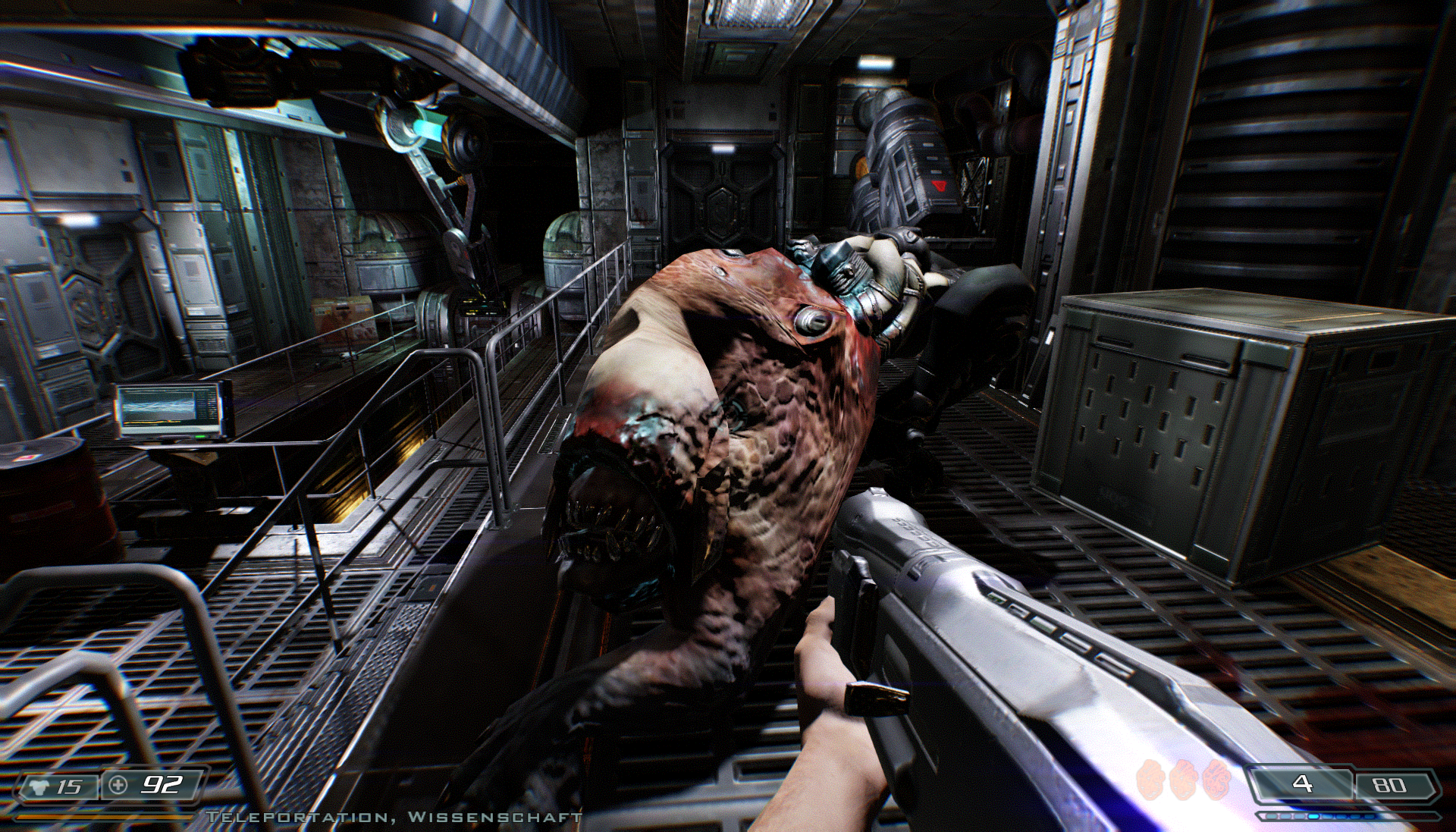
RBDOOM-3-BFG 1.3.0 adds Physically Based Rendering, Global Illumination and TrenchBroom Mapping Support
This release fixes the darkness of Doom 3 and makes the game look more similar to Dead Space and Doom 2016 without adding new textures and materials. RBDOOM-3-BFG 1.3.0 presents Doom 3 BFG in a fresh look and you will be impressed how much beautiful artwork was in Doom 3 which you haven't seen before because the lighting was all pitch black. The original main goal of this 1.3.0 release is enabling modders the ability to make new content using up to date Material & Lighting standards. Adding PBR is a requirement to make the new content look the same in RBDOOM-3-BFG as in Blender 2.9x with Cycles or Eevee and Substance Designer. PBR became the standard material authoring since 2014. Many texture packs for Doom 3 like the Wulfen & Monoxead packs were made before and are heavily outdated. With this release modders can work with modern tools and expect that their content looks as expected.
However the PBR implementation is restricted to standard PBR using the Roughness/Metallic workflow for now. Specialized rendering paths for skin, clothes and vegetation will be in future releases.
Physically Based Rendering
Implementing Physically Based Rendering (PBR) in Doom 3 is a challenge and comes with a few compromises because the Doom 3 content was designed to work with the hardware constraints in 2004 and that even meant to run on a Geforce 3.
The light rigs aren't made for PBR but it is possible to achieve good PBR lighting even with the old content by tweaking the light formulars with a few good magic constants. However I also want to support the modding scene to allow them to create brand new PBR materials made with Substance Designer/Painter or other modern tools so multiple rendering paths have been implemented.
PBR allows artists to create textures that are based on real world measured color values and they look more or less the same in any renderer that follows the PBR guidelines and formulars.
RBDOOM-3-BFG only supports the standard PBR Roughness/Metallic workflow.
Baked Global Illumination using Irradiance Volumes and Image Based Lighting
To achieve the typical PBR look from an artistic point of view it also means to that it is necessary to add indirect lighting. Doom 3 and even Doom 3 BFG had no indirect lighting.
Doom 3 BFG is a big game. Doom 3, Resurrection of Evil and Lost Missions sum up to 47 big single player levels with an average of ~60 - 110 BSP portal areas or let's call them rooms / floors. Each room can have up to 50 shadow casting lights and most of them are point lights. I needed a good automatic solution that fixes the pitch black areas without destroying the original look and feel of the game. I also needed to add environment probes for each room so PBR materials can actually reflect the environment.
So RBDOOM-3-BFG comes with 2 systems to achieve this and both are automatic approaches so everything can be achieved in a reasonable amount of time. The first system are environment probes which are placed into the center of the rooms. They can also be manually tweaked by adding env_probe entities in the maps. They use L4 spherical harmonics for diffuse reflections and GGX convolved mip maps for specular reflections. The second system refines this by using a light grid for each room which provides a sort of a localized/improved version of the surrounding light for each corner of the room.
Irradiance Volumes aka Light Grids
RBDOOM-3-BFG 1.3.0 brings back the Quake 3 light grid but this time the grid points feature spherical harmonics encoded as octahedrons and it can be evaluated per pixel. This means it can be used on any geometry and serves as an irradiance volume. Unlike Quake 3 this isn't radiosity which is limited to diffuse only reflections. The diffuse reflectivity is built using all kinds of incoming light: diffuse, specular and emissive (sky, light emitting GUIs, VFX).
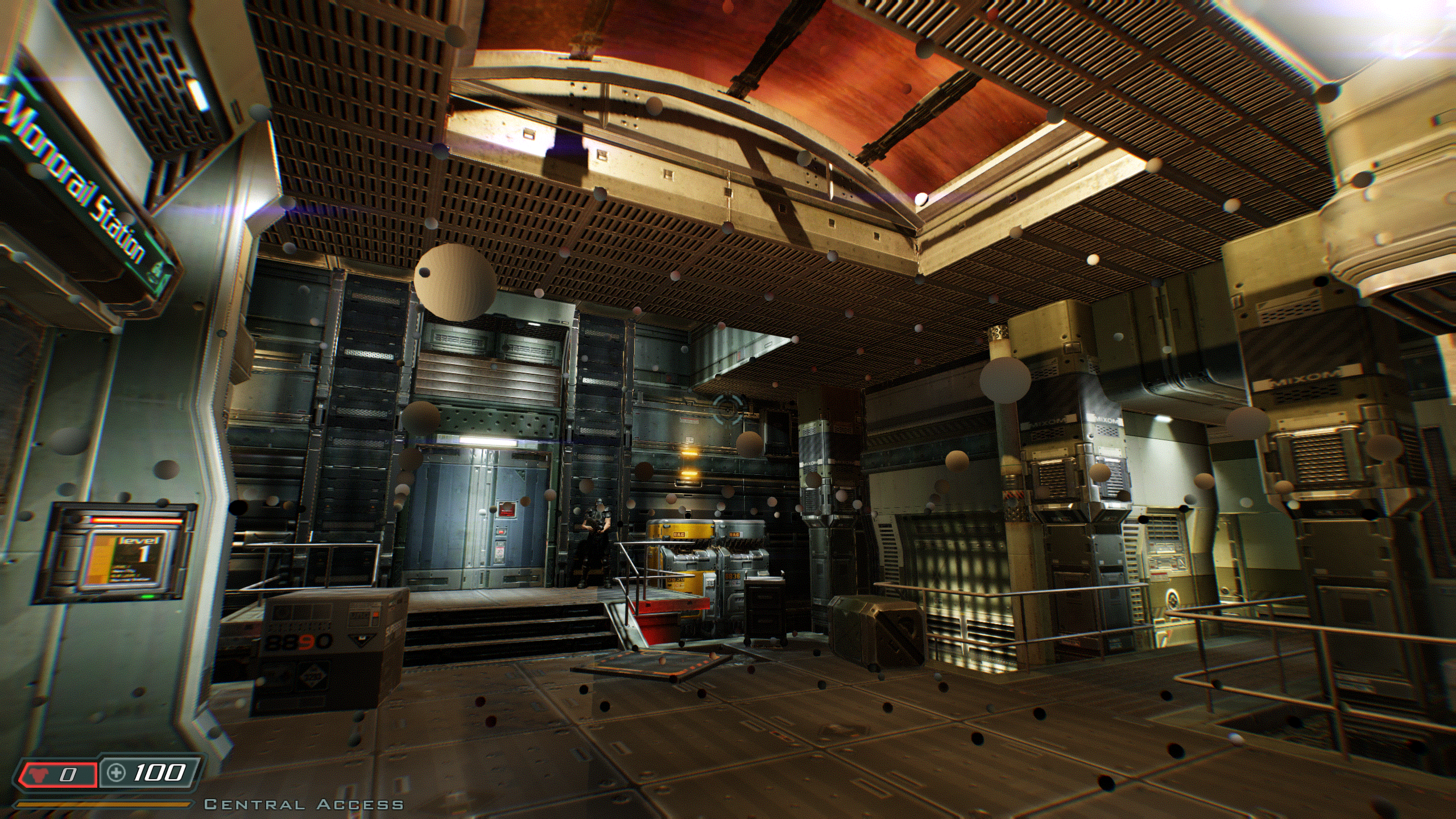
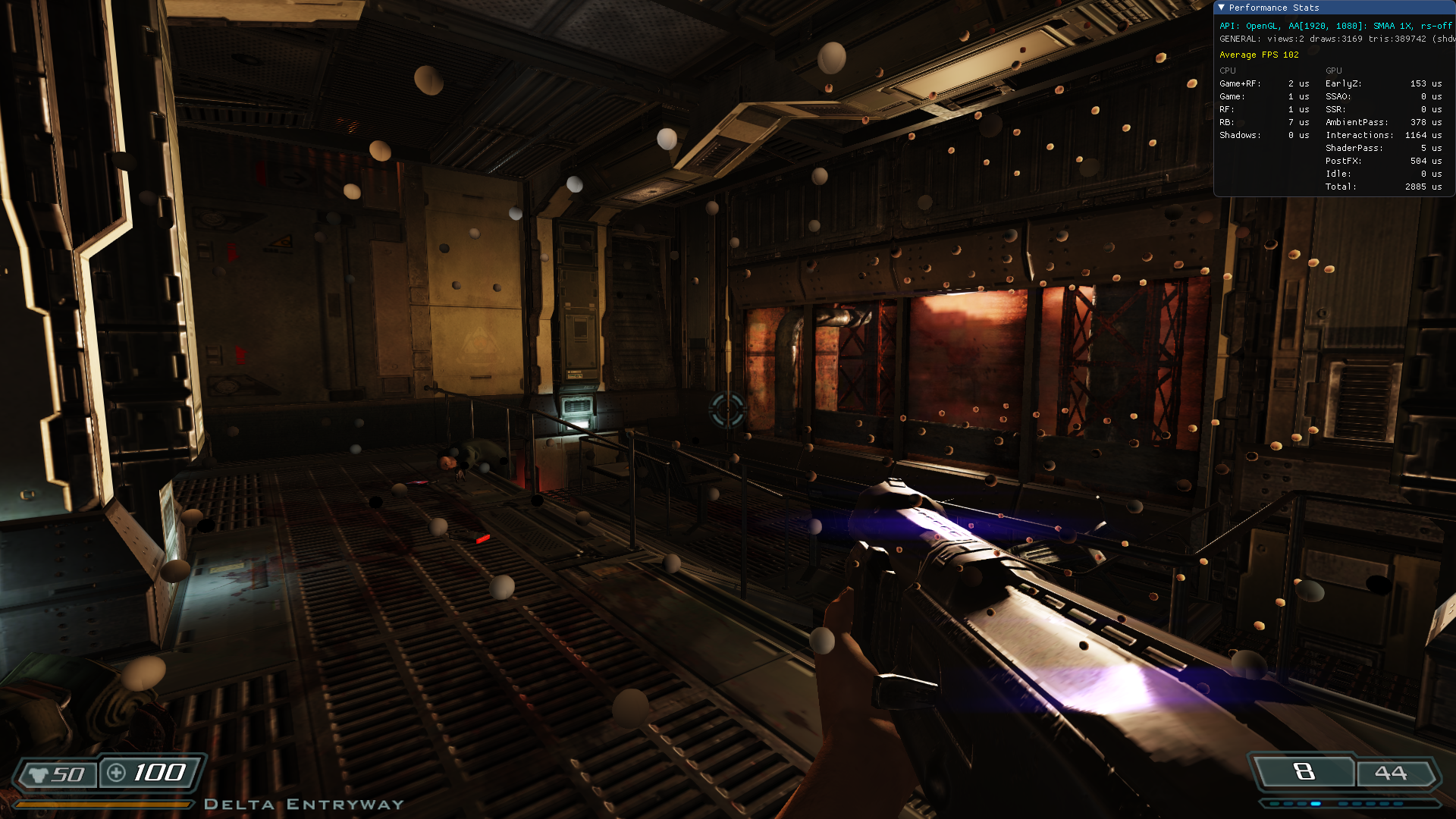
Lightgrids can be baked after loading the map and by typing:
bakeLightGrids [<switches>...]
<Switches>
limit[num] : max probes per BSP area (default 16384)
bounce[num] : number of bounces or number of light reuse (default 1)
grid( xdim ydim zdim ) : light grid size steps into each direction (default 64 64 128)This will generate a .lightgrid file next to your .map file and it will also store a light grid atlas for each BSP area under env/maps/<path/to/your/map/>

Limit is 16384 by default and means the maximum number of light grid points in a single light grid. Quake 3 had one light grid that streched over the entire map and distributed lighting every 64 x 64 x 128 units by default. If the maps were too big then q3map2 made the default grid size broader like 80 x 80 x 144, 96 x 96 x 160 and so on until the maximum number of light grid points was reached.
The Quake 3 approach wouldn't work with Doom 3 because the maps are too big and it would result in up to 800k probes for some maps or the grid density would very coarse.
RBDOOM-3-BFG uses the bounding size of the BSP portal areas and puts smaller light grids into those BSP areas.
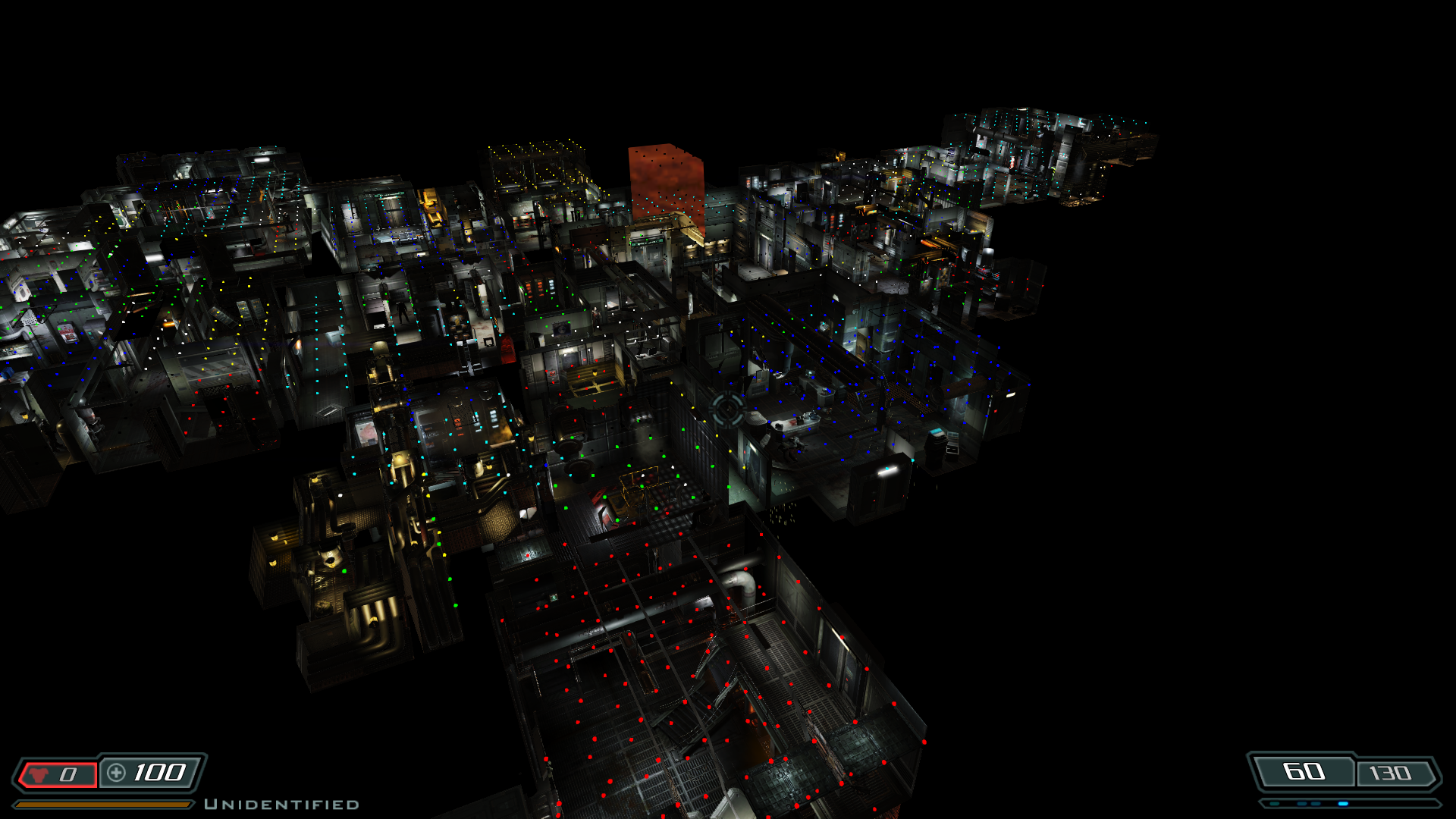
This way we can maintain a good grid density and avoid wasting storage because of light grid points that are in empty space.
code-line" wrote: But what is an Irradiance Volume or Light Grid exactly?
<p><p><p>It tells each model or lit pixel how the indirect diffuse lighting is coming from any direction. The Probulator page by Yuri O'Donnell has some good examples:</p> <p data-line="89">Left: The captured view using a panorama layout. Right: The Diffuse lighting using Level 4 Spherical Harmonics aka Irradiance.
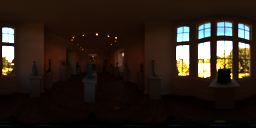
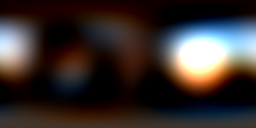
Now think of this for each of the grid points in RBDOOM-3-BFG. If a model is placed between those probes the lighting will be interpolated by the nearest 8 grid points similar like in Quake 3.
Quake 3 only stored the dominant light direction, the average light color of that direction and an ambient color term for each grid point. In RBDOOM-3-BFG you basically can have the diffuse lighting information for any world space direction instead. This is a way more advanced technique.
Image Based Lighting and Environment Probes
Environment probes supplement the light grids. While light grids provide diffuse lighting information the signal isn't good enough to provide plausible specular light reflections. This is where environment probes are needed.
If a level designer doesn't put any env_probe entities into a map then they are automatically distributed through the map using the BSP area bounds and placed in the center of them.
Environment probes can be computed after loading the map and by typing:
bakeEnvironmentProbesThis will generate EXR files in env/maps/<path/to/your/map/>.
The environment probes use an octahedron encoding and the specular mipmaps are convolved using the Split Sum Approximation by Brian Karris [Epic 2013]. Convolving the environment probes is done on the CPU using the id Tech 5 multi threading code so it will consume all your available cores.
For artists this basically means if you increase the roughness in your material then you increase the mip map level of the environment probe it samples light from and it gets blurier.
Fallback for Missing Data
If you haven't downloaded the additional baked light data from the RBDOOM-3-BFG ModDB Page and just run RBDOOM-3-BFG.exe with the required DLLs (or you built it yourself) it will use an internal fallback. RBDOOM-3-BFG.exe has one prebaked environment probe that is compiled into the executable.
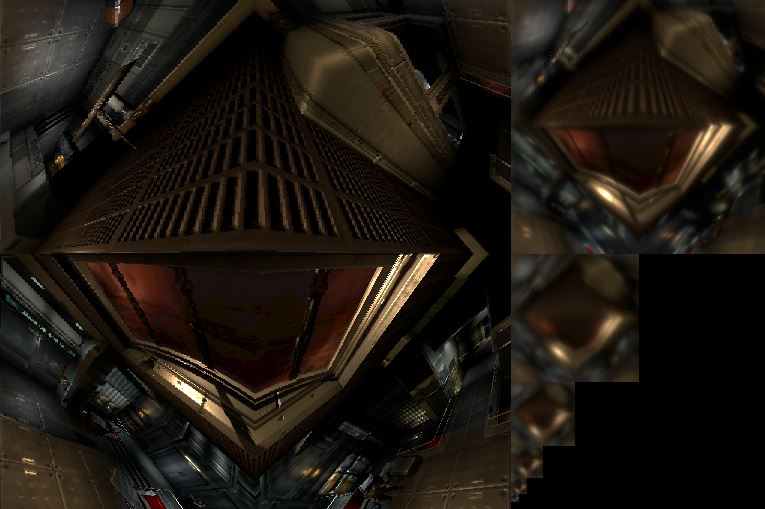

It's the light data from the Mars City 1 lobby in the screenshot above. Using this data for the entire game is inacurrate but a better compromise than using a fixed global light direction and some sort of Rim lighting hack like in version 1.2.0. The default irradiance / radiance data gives the entire game a warmer look and it fits for being on Mars all the time.
Some Examples of Indirect Lighting
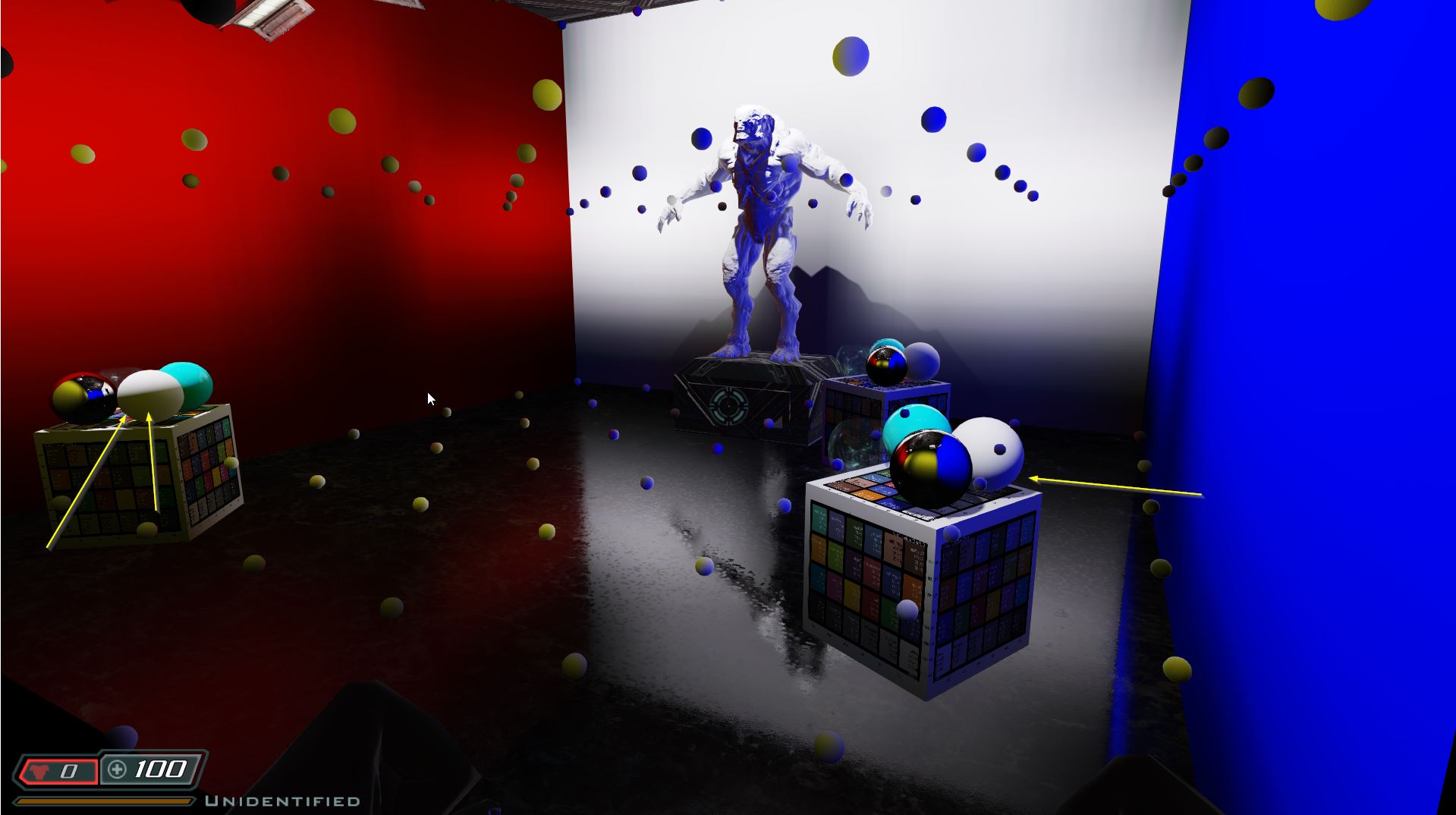
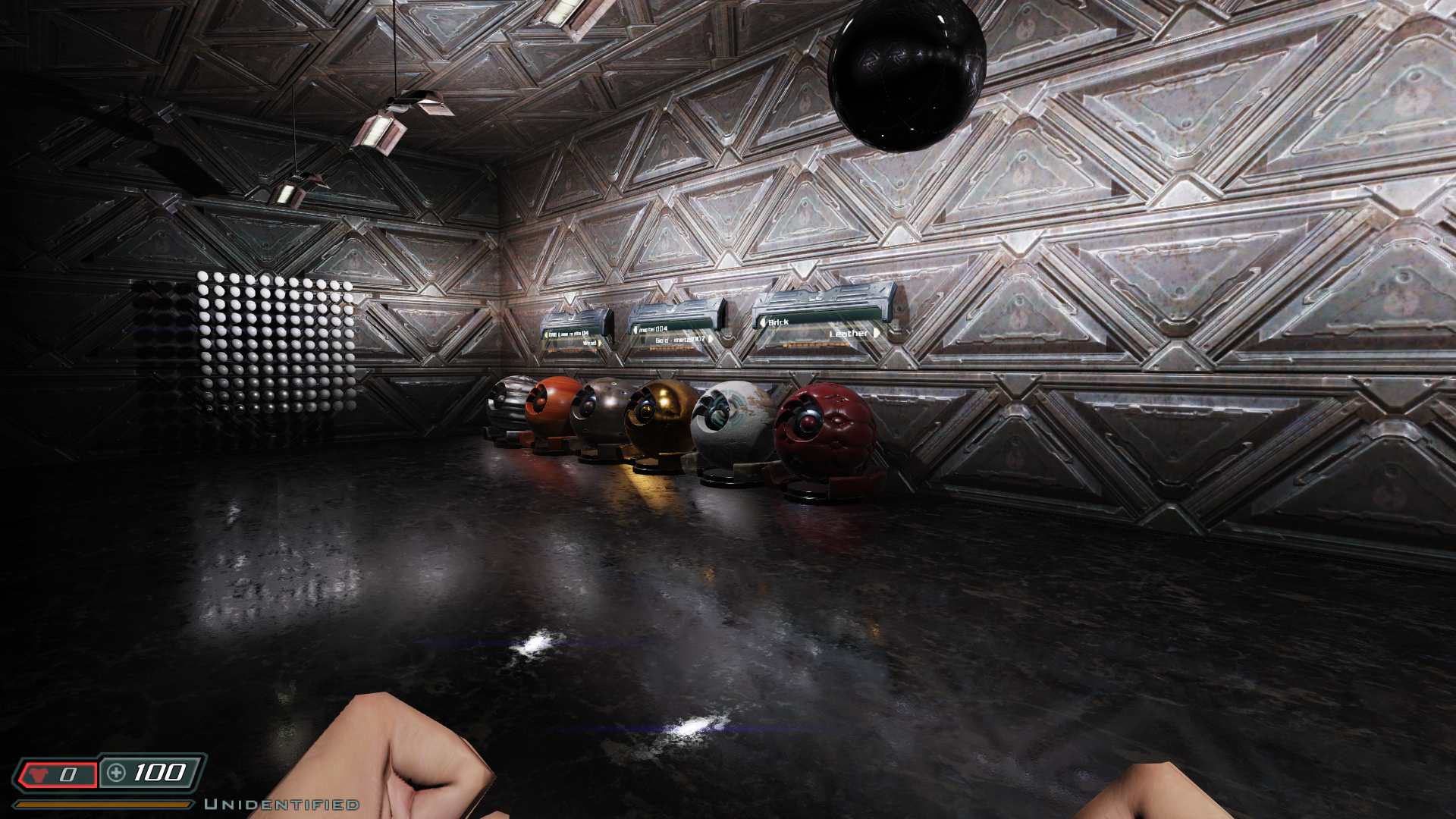
Single spot light render with direct lighting only (what you know from regular Doom 3)
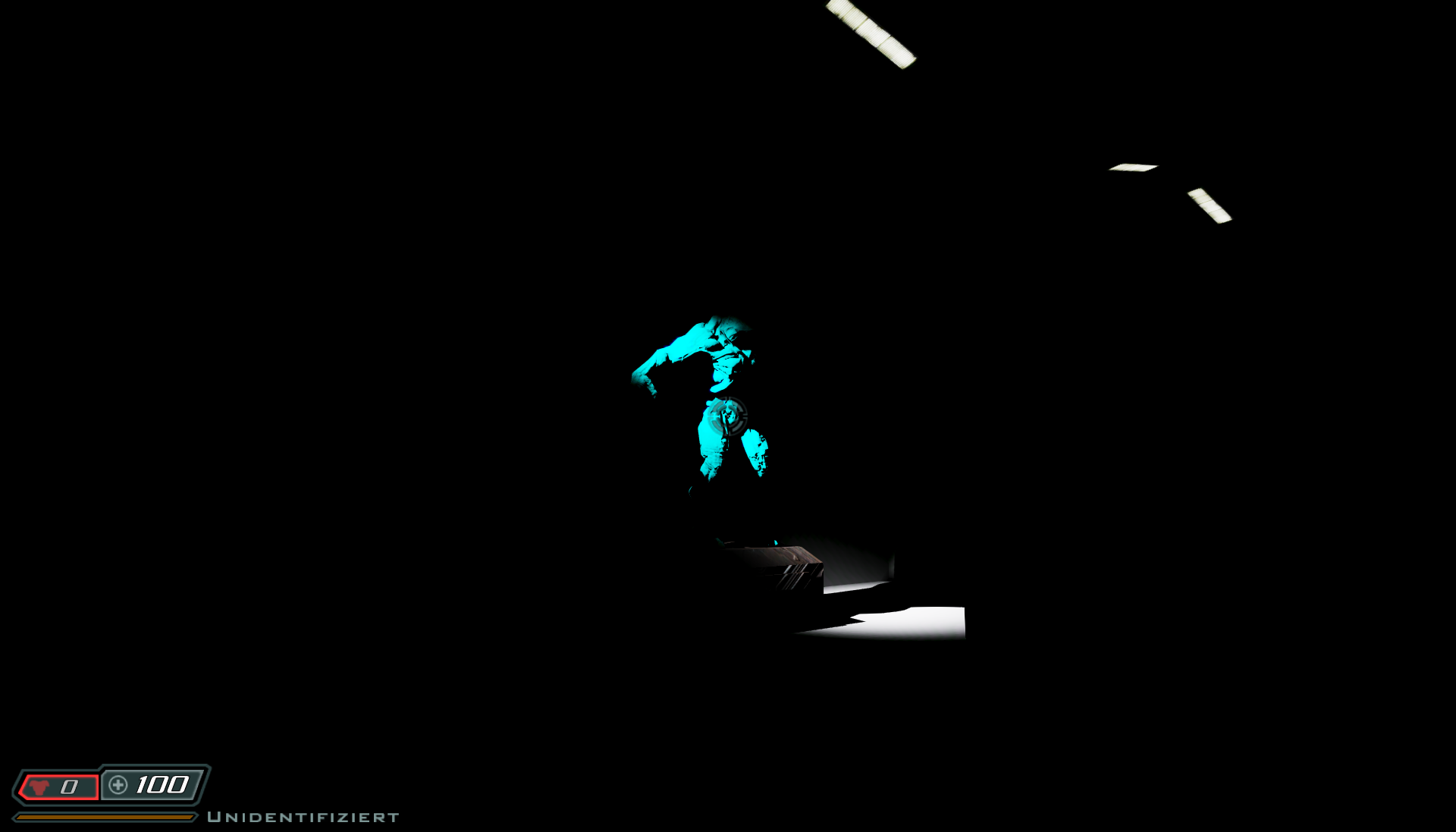
Single spot light render causing indirect light bounce using the new irradiance light grid in RBDOOM-3-BFG combined with SSAO
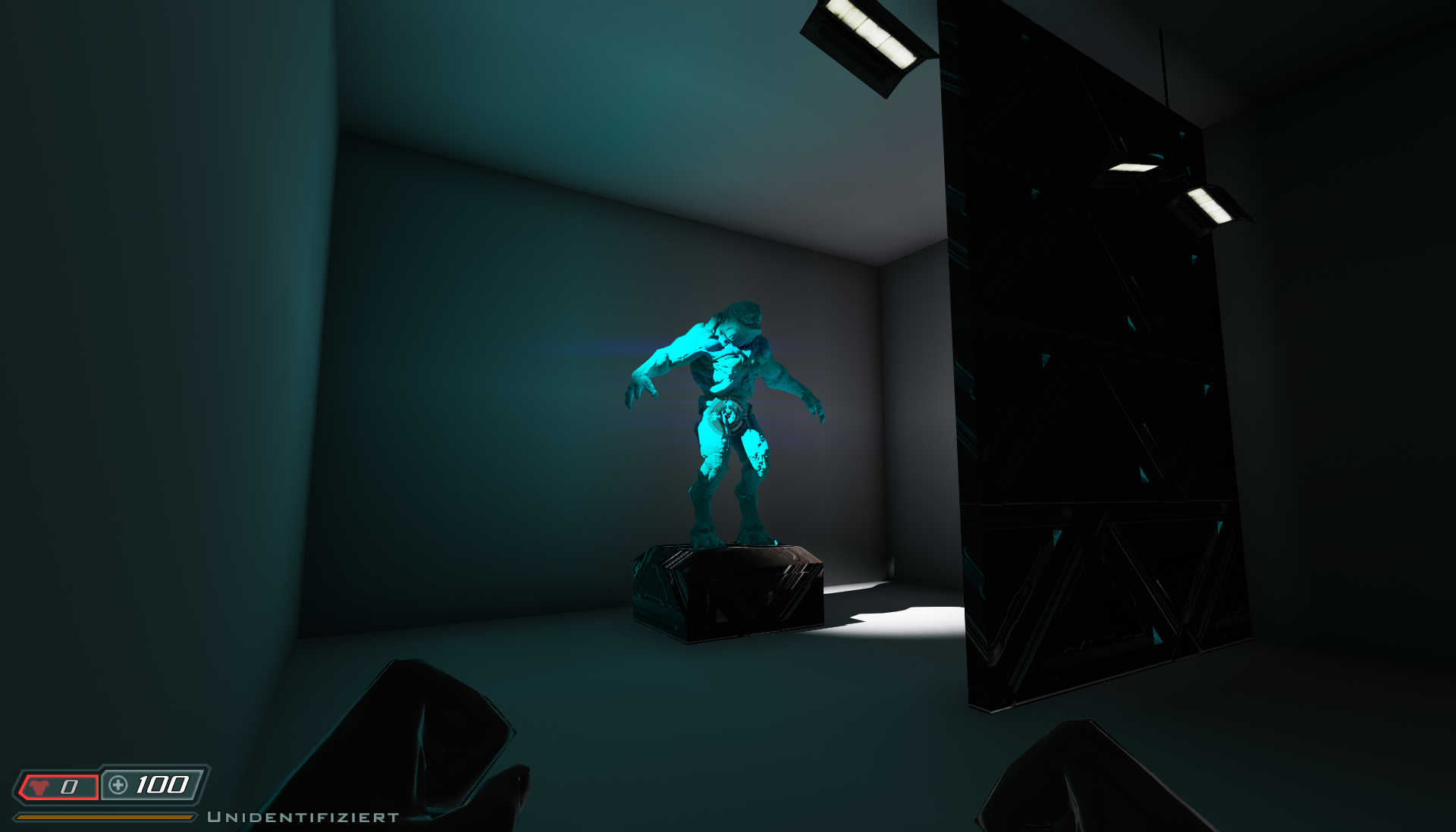
Raytraced reference in Blender 2.83 with Cycles raytracing
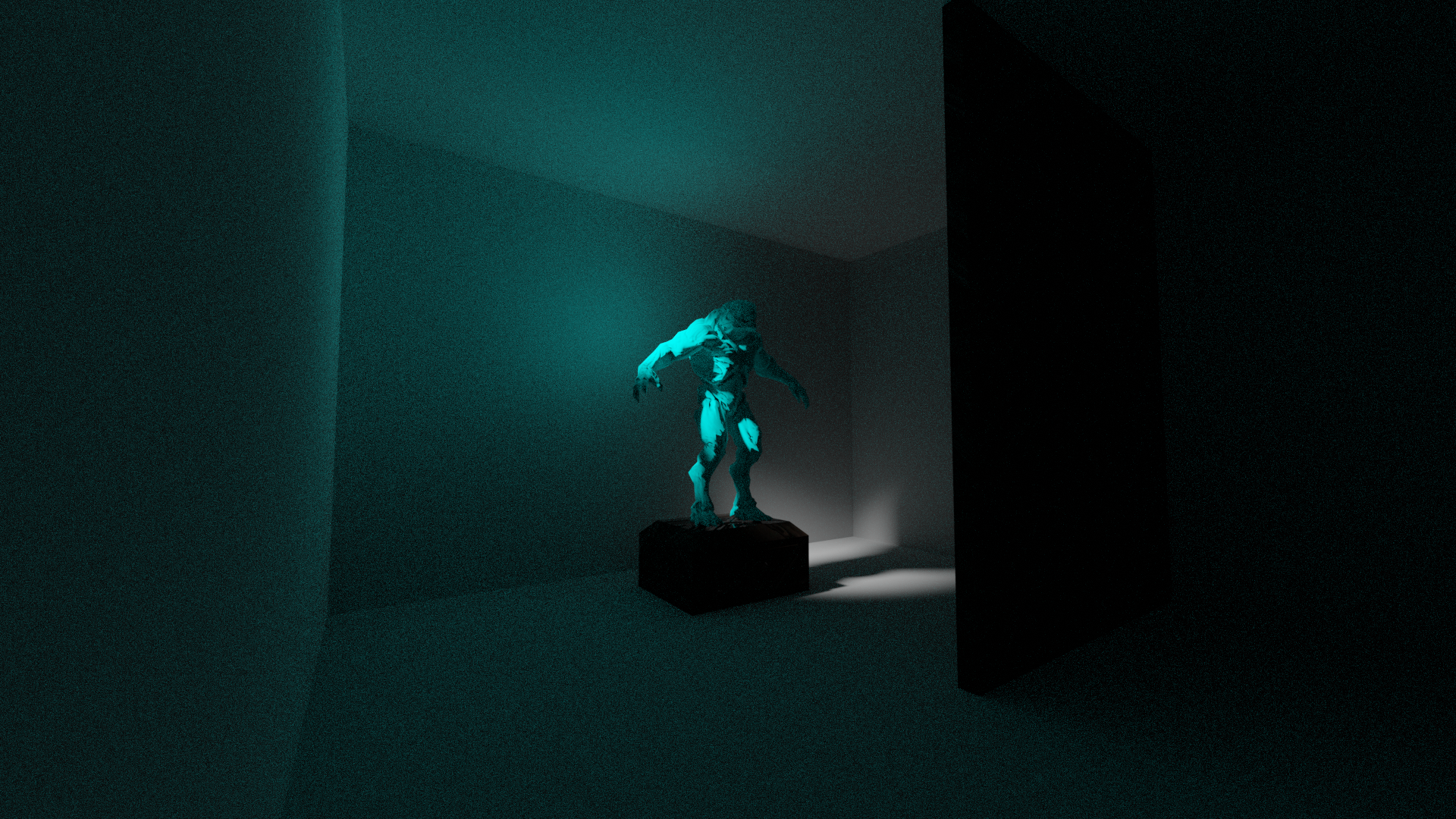
First: No global illumination. Ambient is pitch black like in original Doom 3. Second: Extra ambient pass for global illumination with r_forceAmbient 0.5.
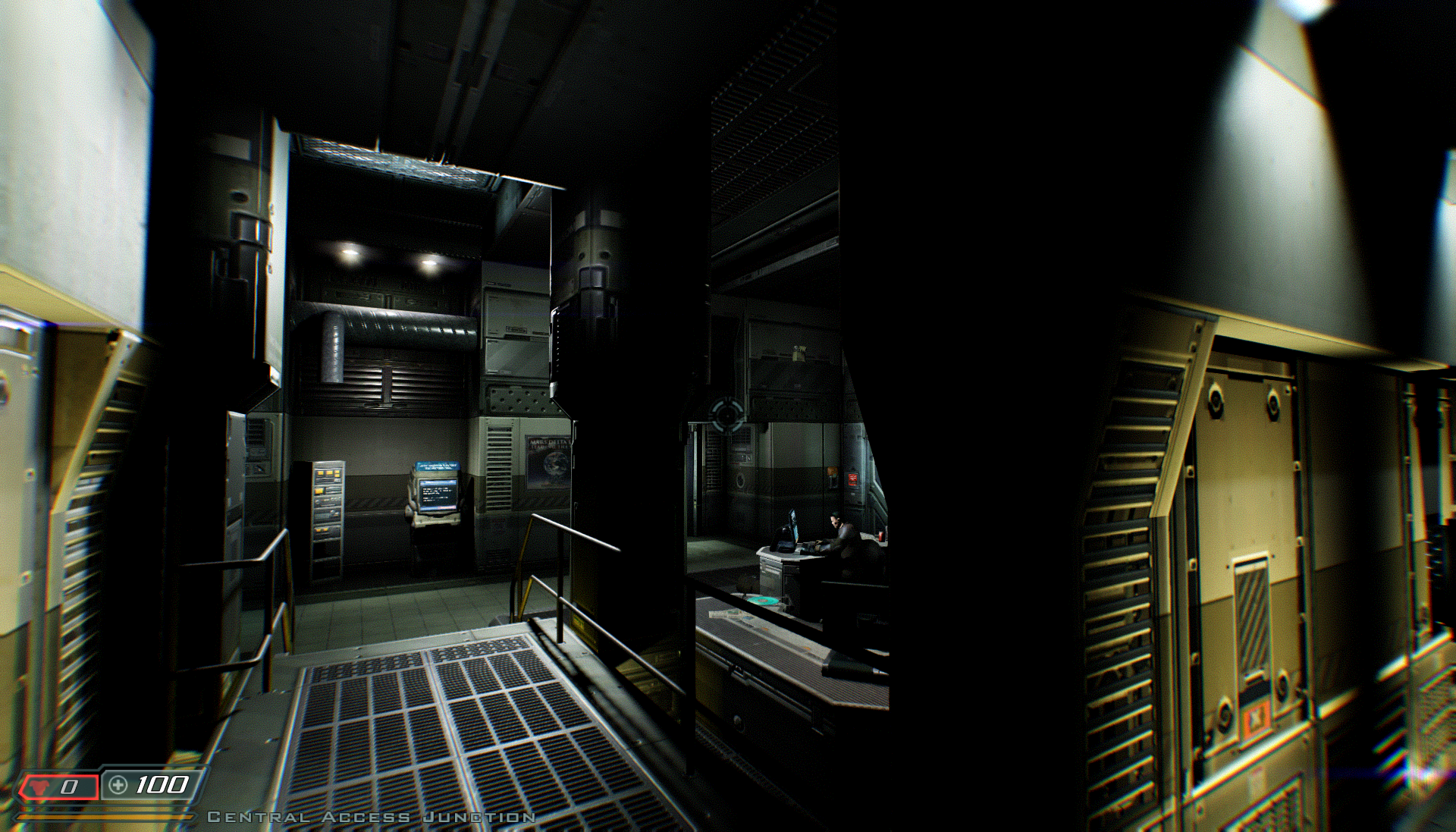
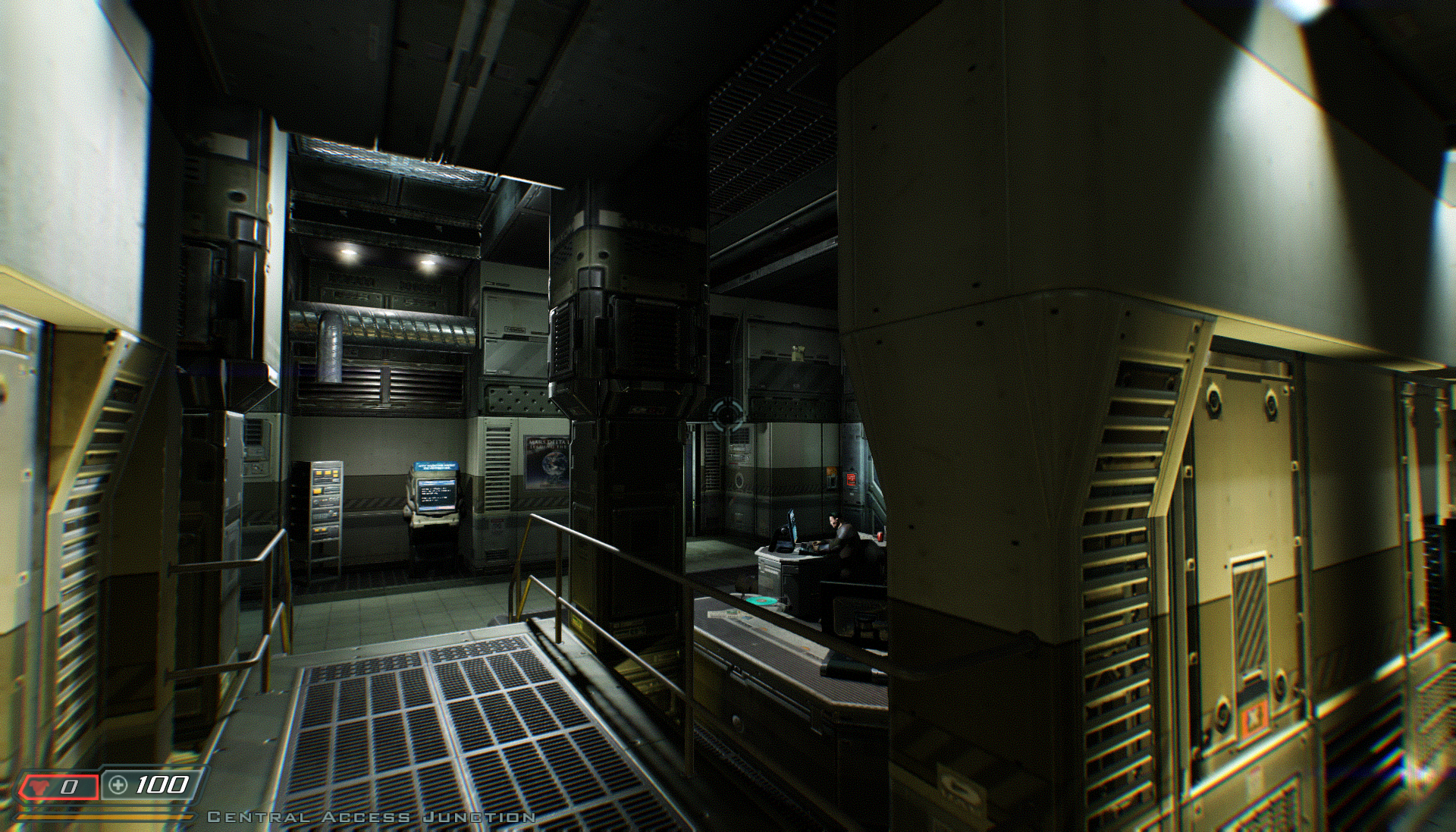
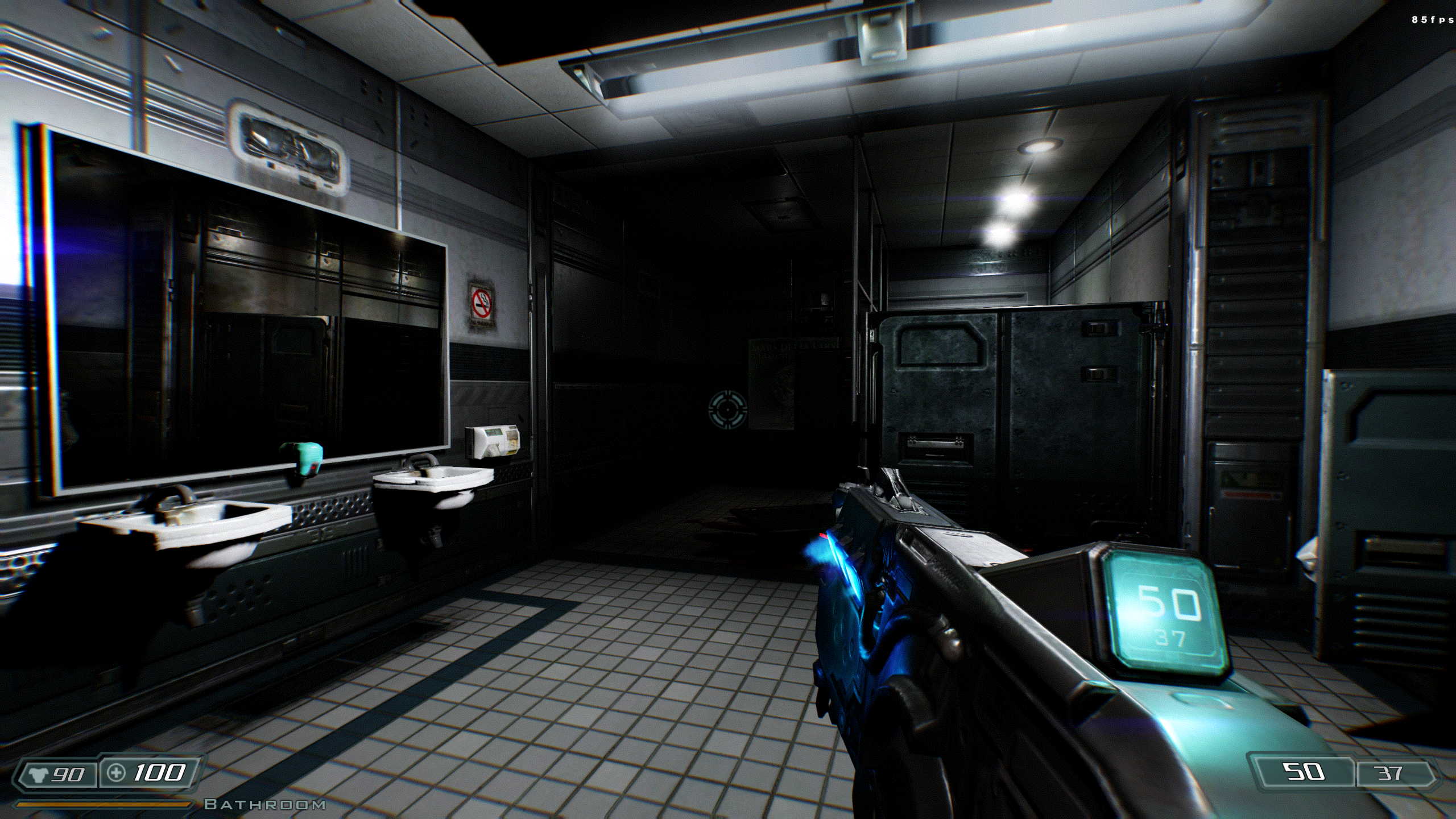
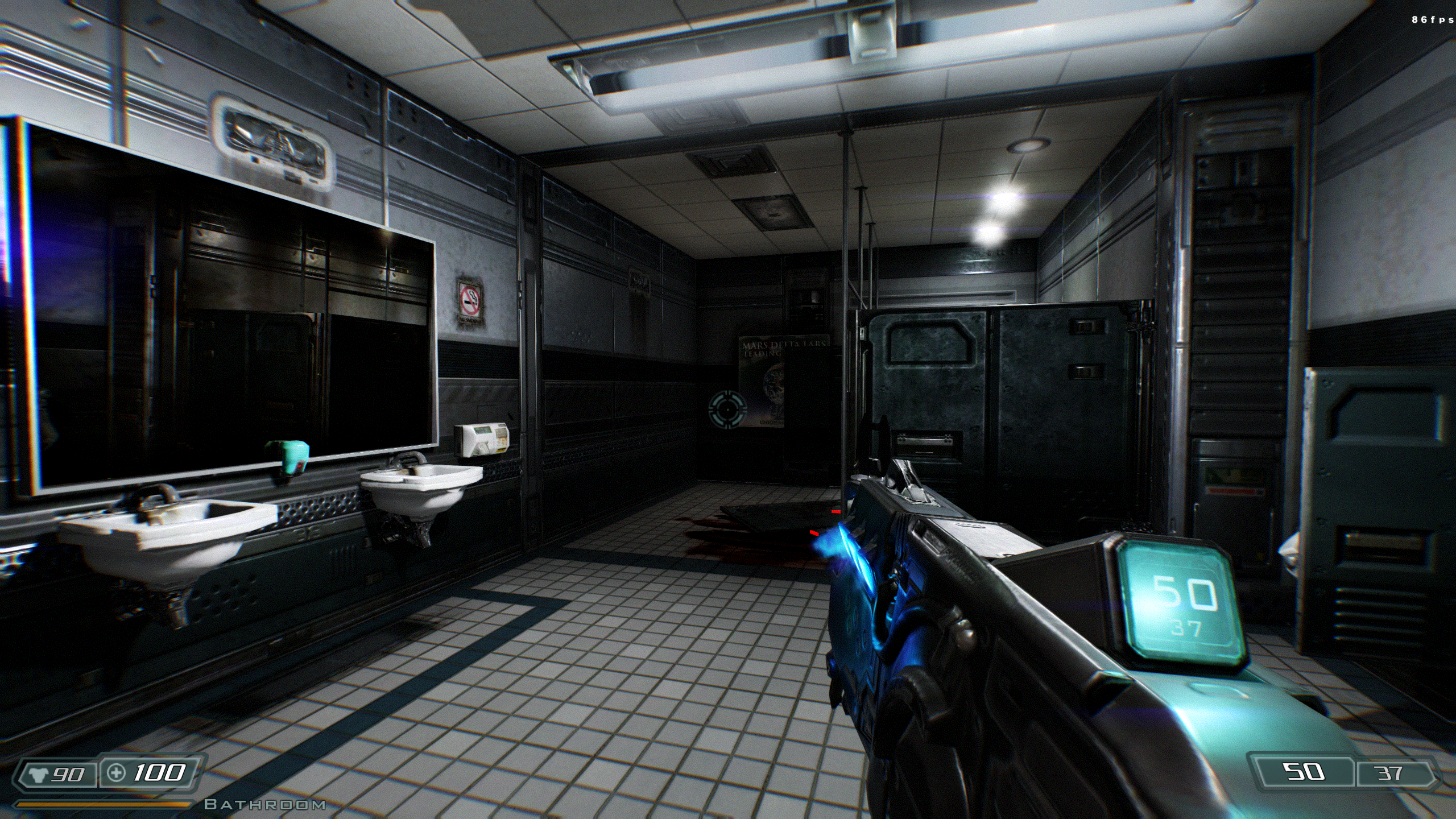
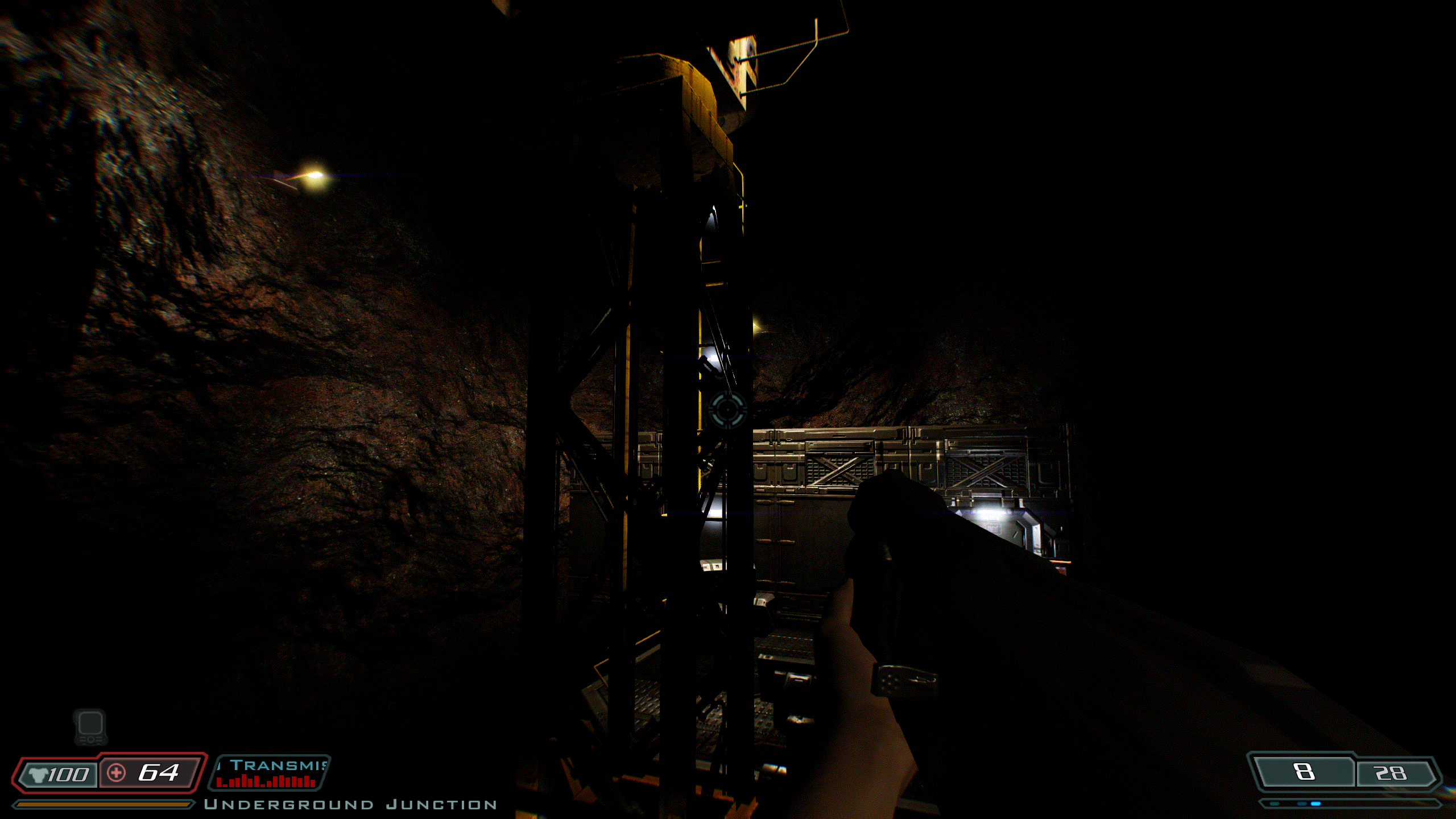
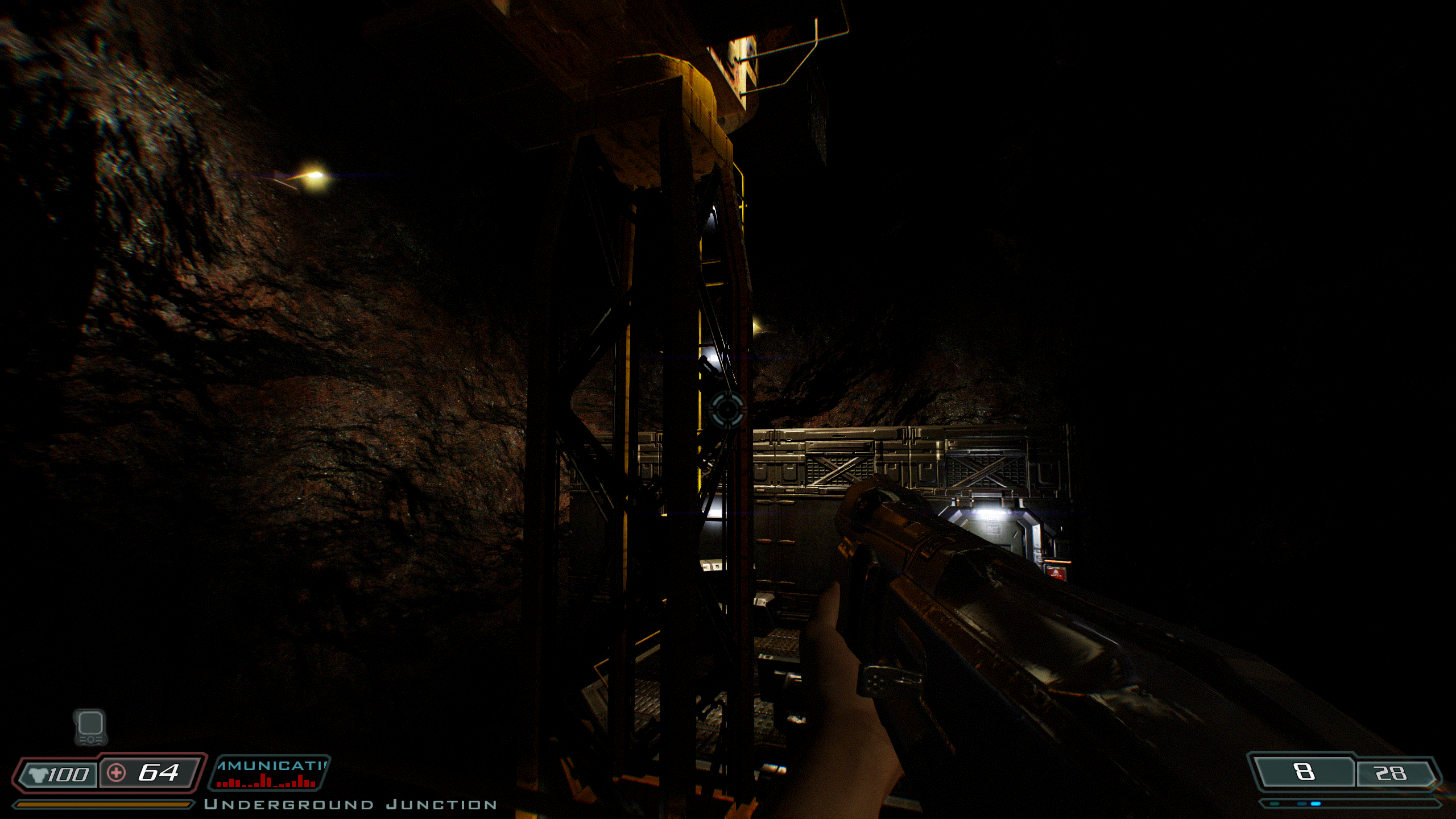
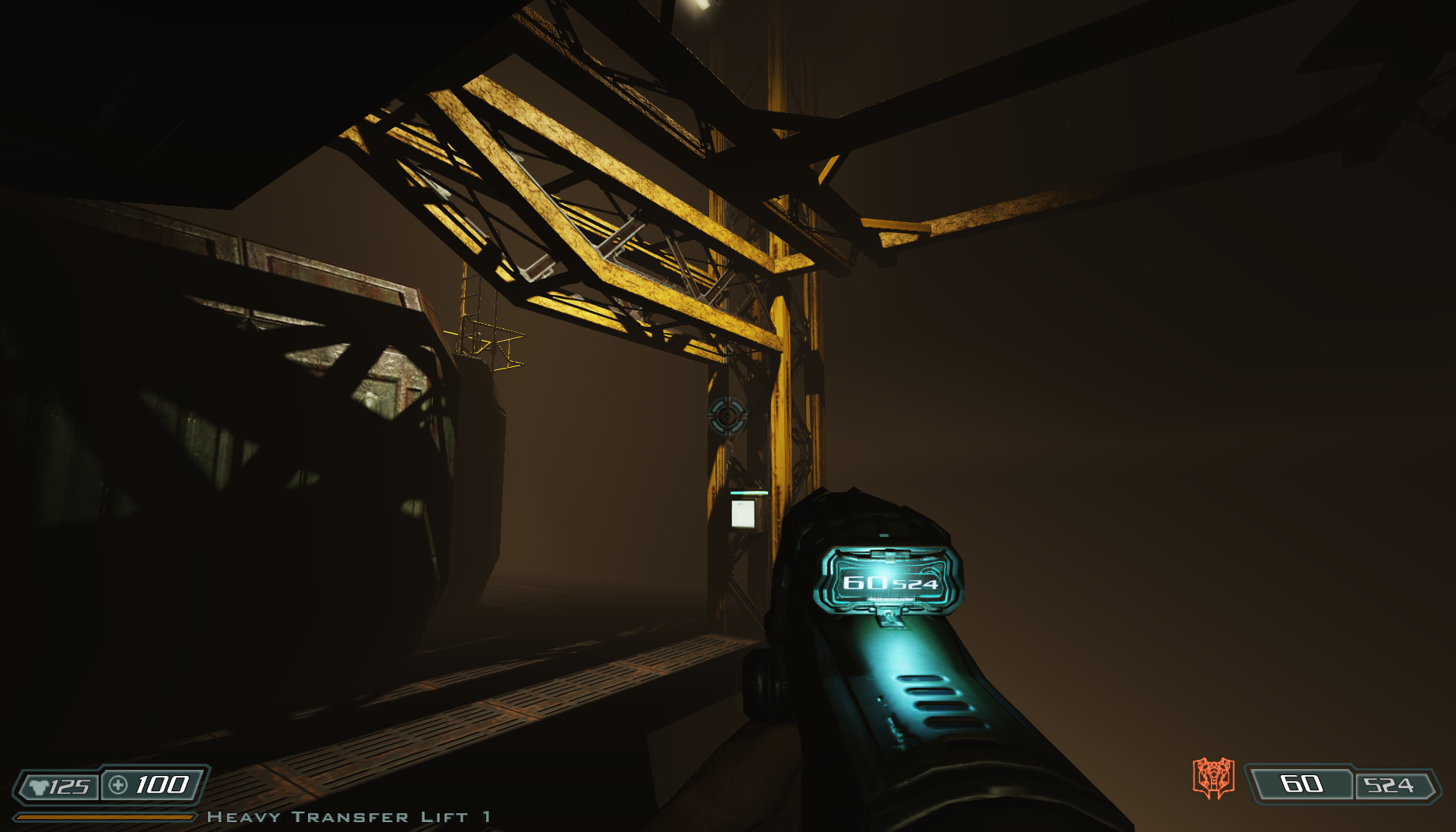
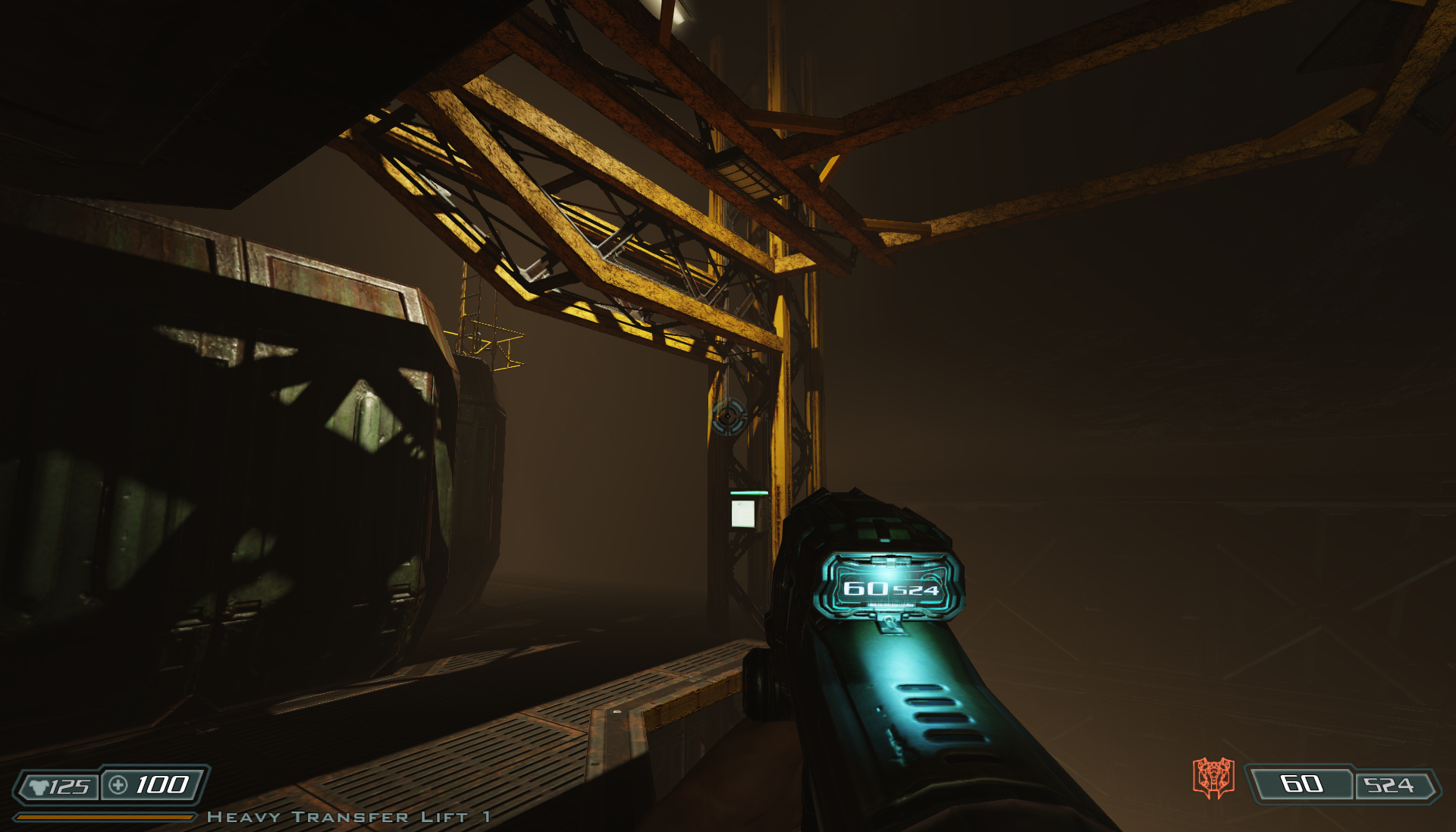
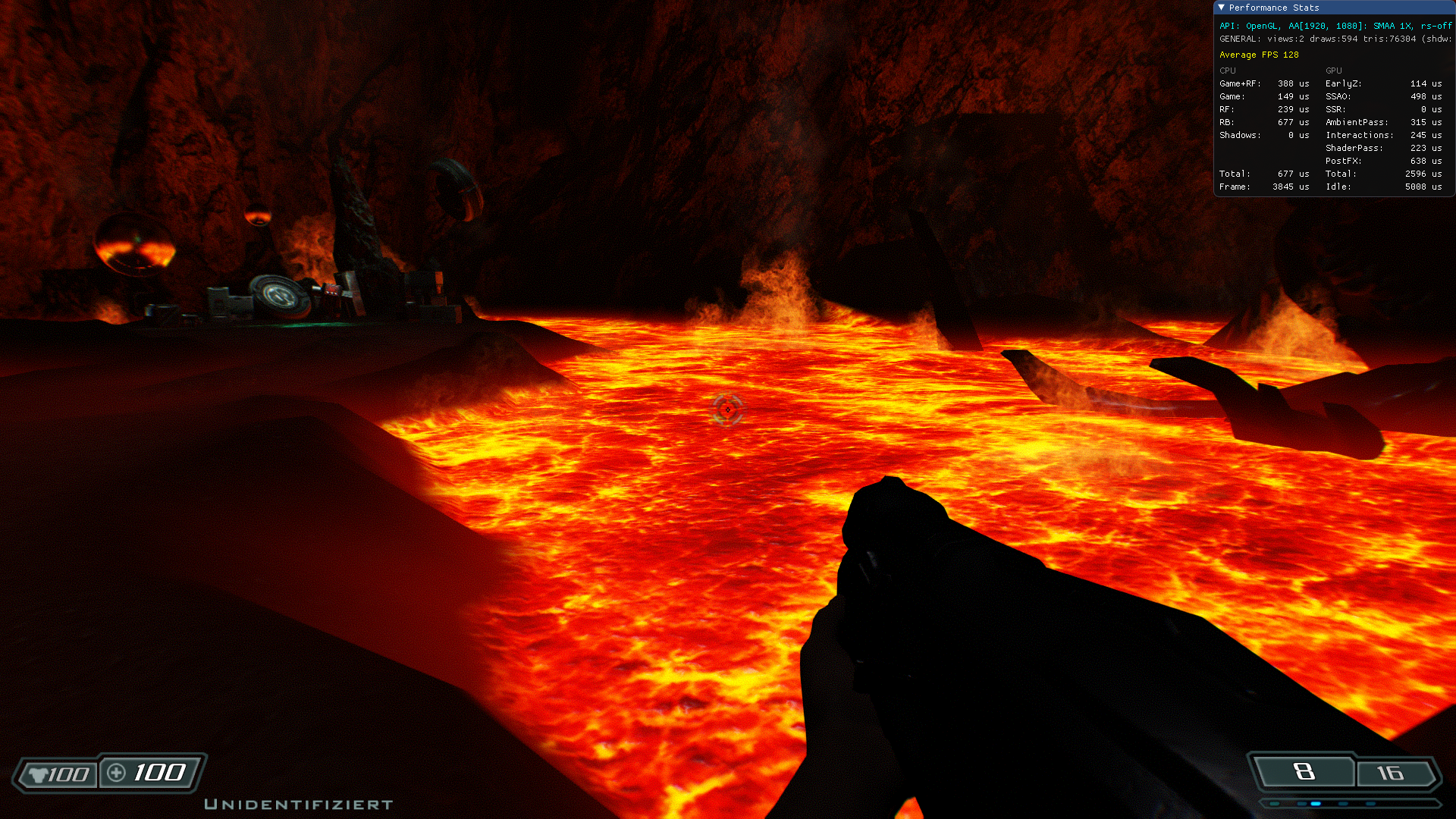
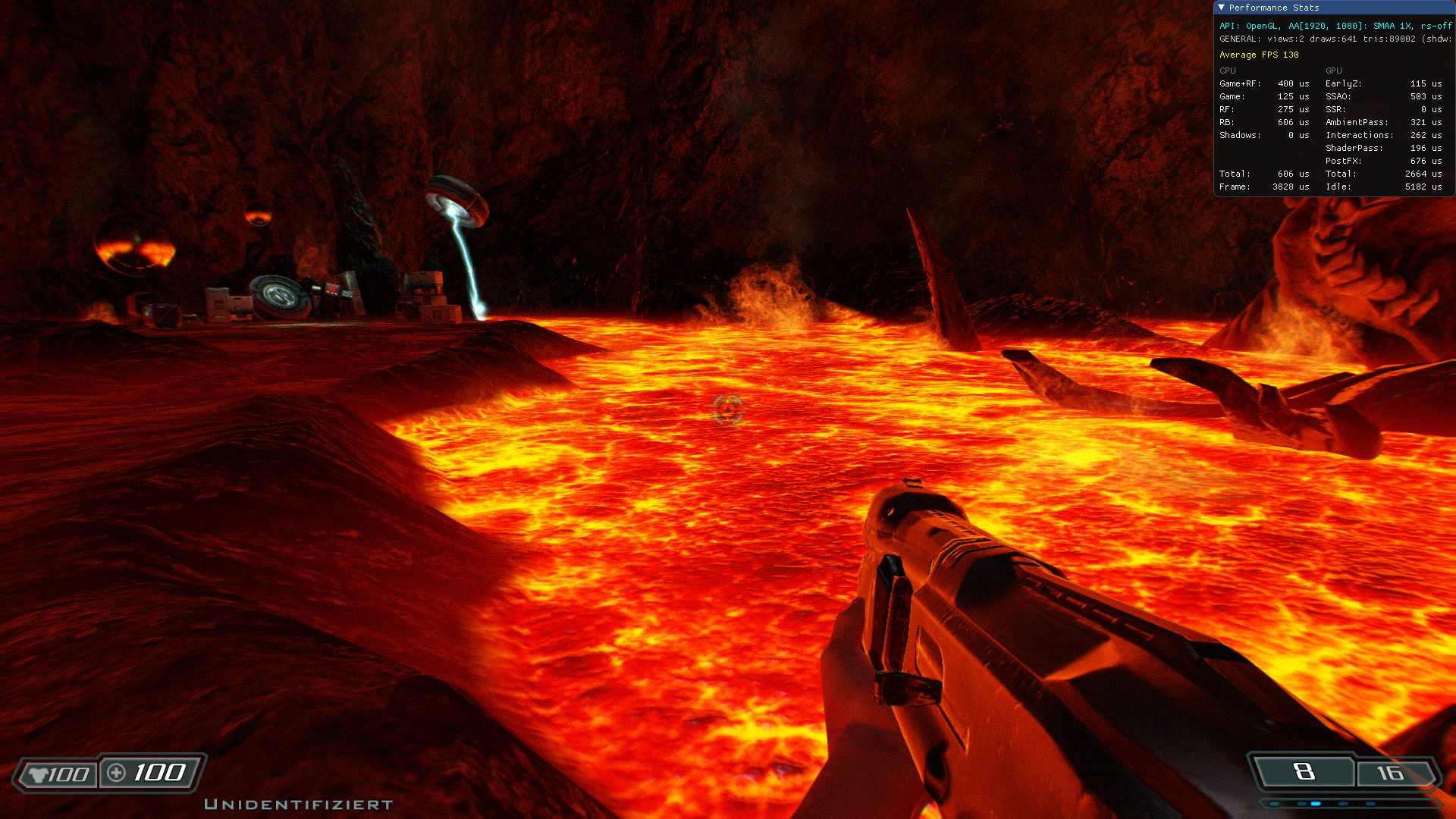
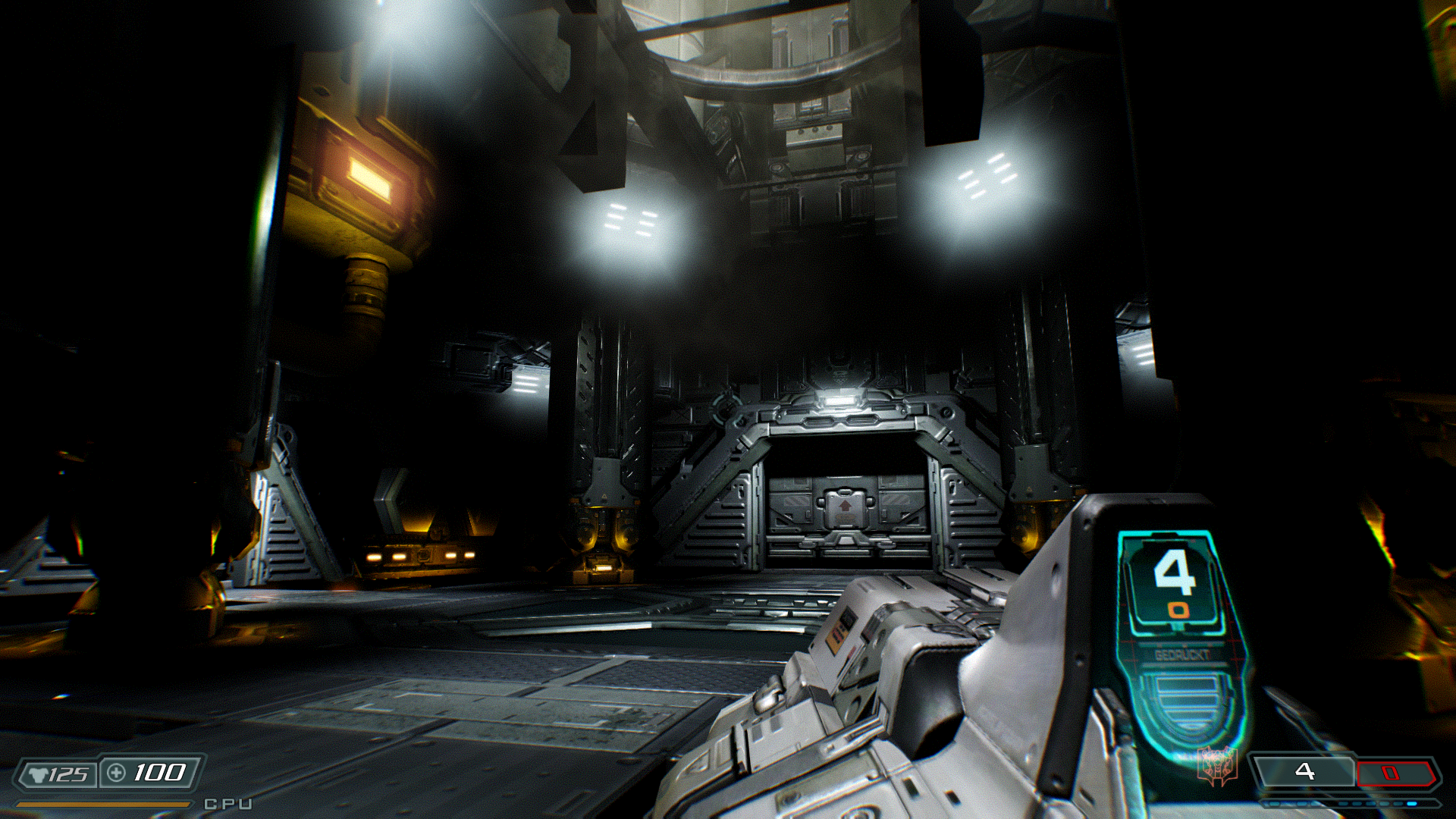
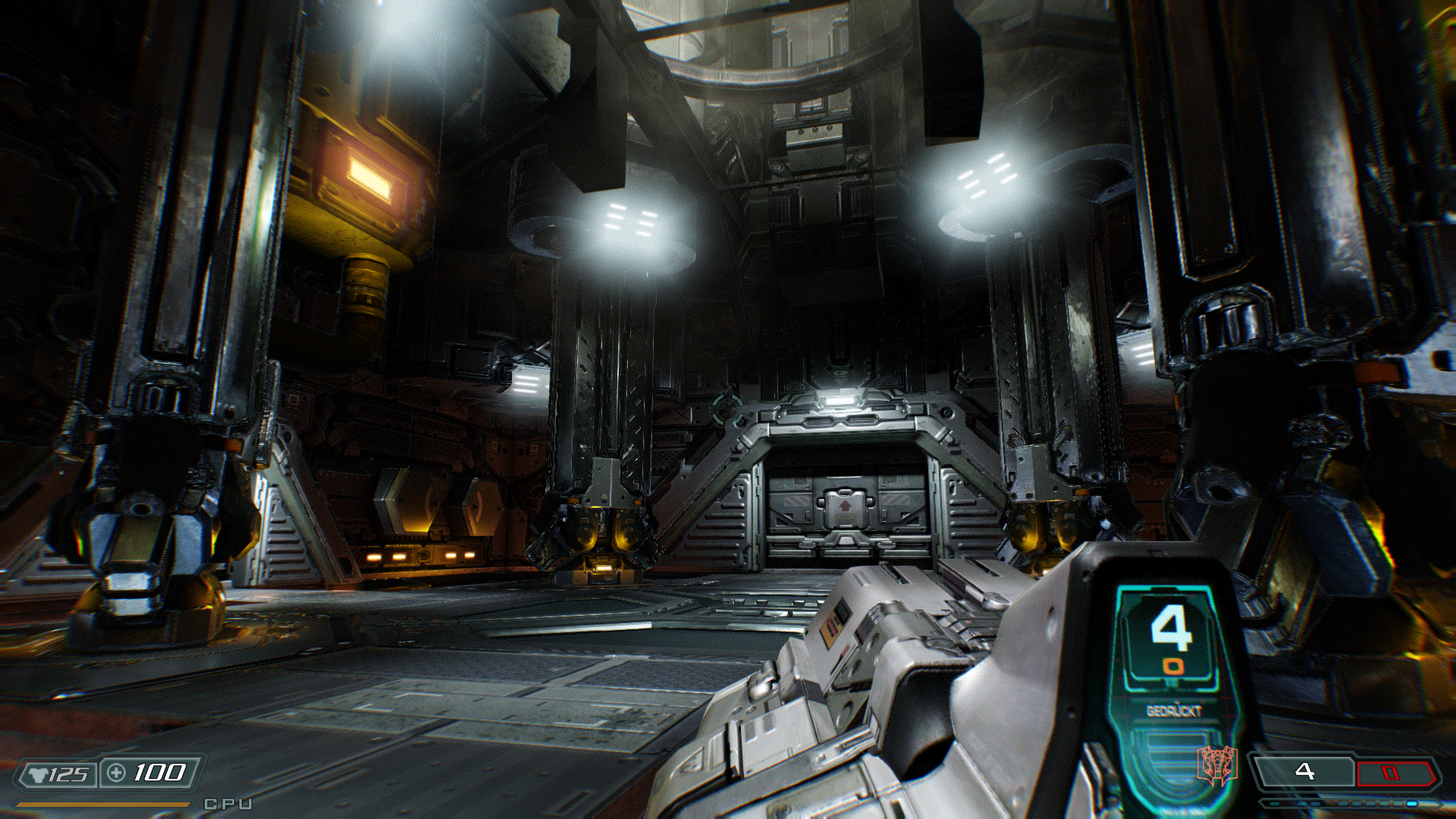
PBR Texture format
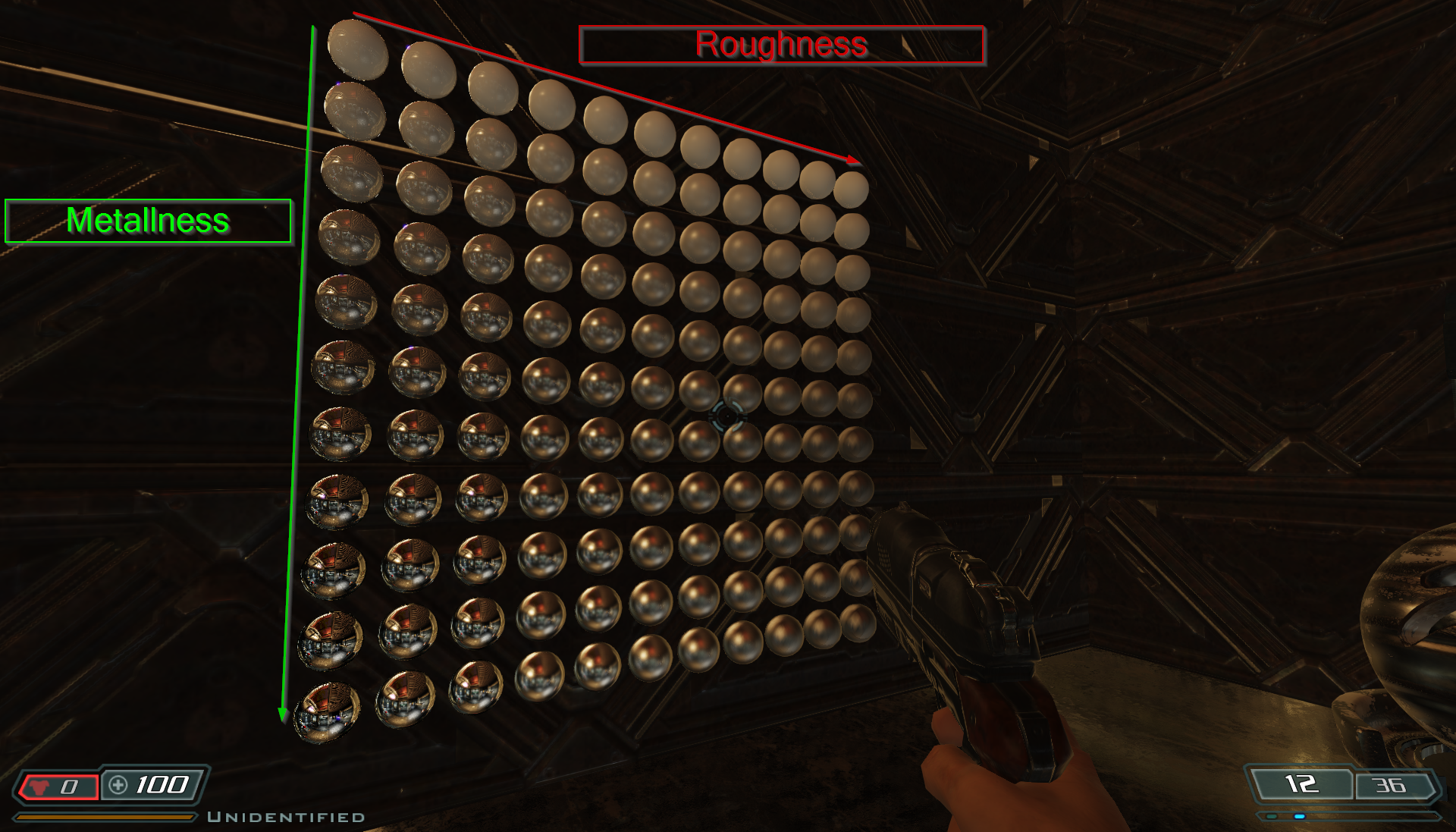
In Doom 3 a classic simple materials looks like this:
textures/base_wall/snpanel2rust
{
qer_editorimage textures/base_wall/snpanel2rust.tga
bumpmap textures/base_wall/snpanel2_local.tga
diffusemap textures/base_wall/snpanel2rust_d.tga
specularmap textures/base_wall/snpanel2rust_s.tga
}It's usually rendered with Blinn-Phong specular with a fixed specular exponent. Specularmaps are more or less Gloss maps.
In RBDOOM-3-BFG it uses the PBR GGX Cook-Torrence formular and you can vary the roughness along the material like in other modern engines and you usually define a texture with the _rmao suffix.
RMAO Image Channels Description:
Red = Roughness
Green = Metalness
Blue = Ambient Occlusion
Example material:
models/mapobjects/materialorb/orb
{
qer_editorimage models/mapobjects/pbr/materialorb/substance/metal04_basecolor.png
basecolormap models/mapobjects/pbr/materialorb/substance/metal04_basecolor.png
normalmap models/mapobjects/pbr/materialorb/substance/metal04_normal.png
specularmap models/mapobjects/pbr/materialorb/substance/metal04_rmao.png
}The engine will also look for _rmao.[png/tga] overrides for old materials and if it finds those it will render them using a better PBR path. Old school specularmaps also go through a GGX pipeline but the roughness is estimated from the glossmap.
The Ambient Occlusion will be mixed with the Screen Space Ambient Occlusion and will only affect indirect lighting contributed by the environment probes.
Filmic Post Processing
TL;DR If you enable it then you play DOOM 3 BFG with the optics of a Zack Snyder movie.
This release adds chromatic abberation and filmic dithering using Blue Noise. The effect is heavy and is usually aimed in Film production to mix real camera footage with CG generated content.
Dithering demonstration: left side is quantized to 3 bits for each color channel. Right side is also only 3 bits but dithered with chromatic Blue Noise. The interesting fact about the dithering here is shown in the upper debug bands. The first top band is the original signal. The second shows just 8 blocks and if you dither the those blocks with Blue Noise then it is close to the original signal which is surprising.
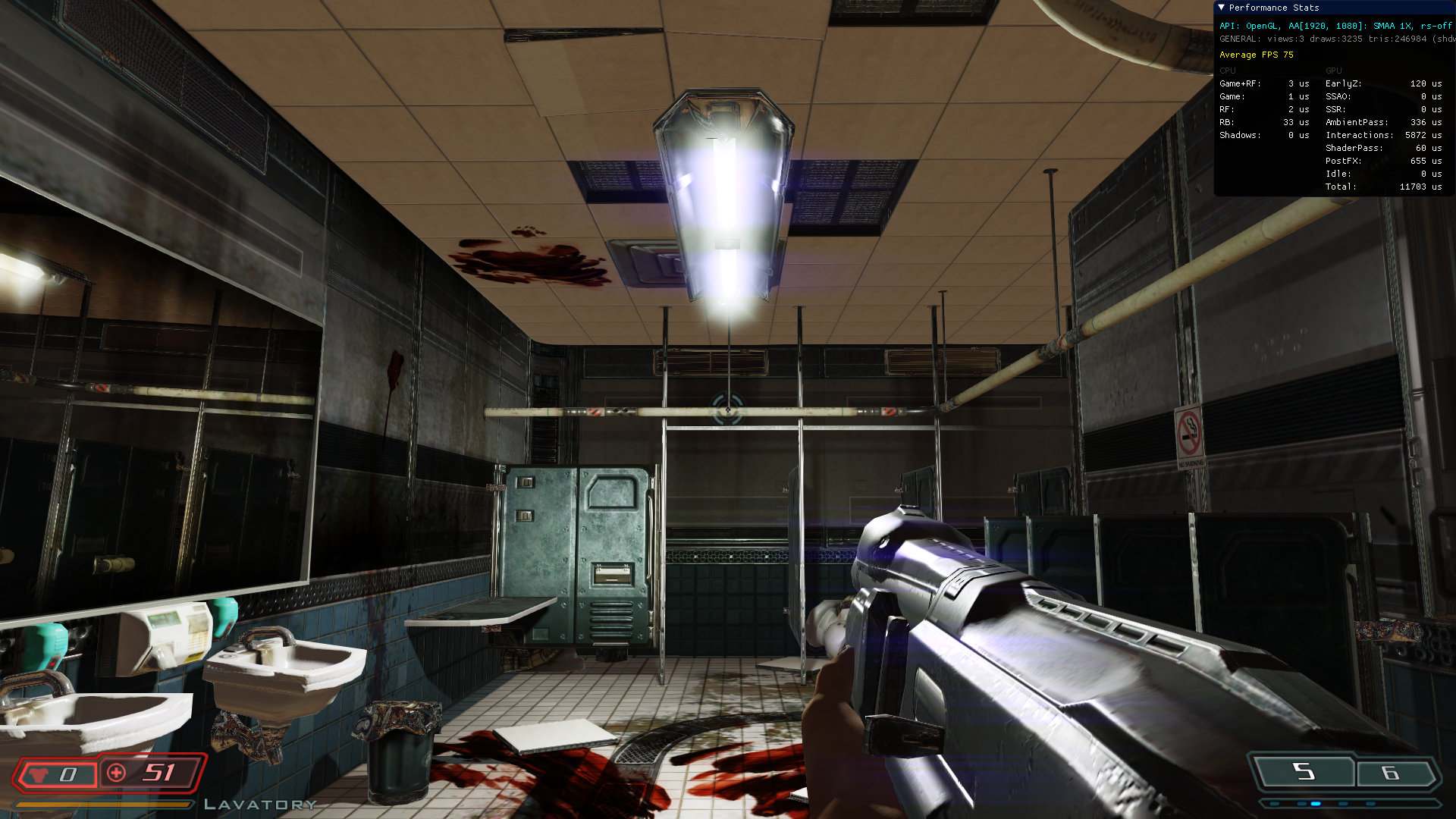
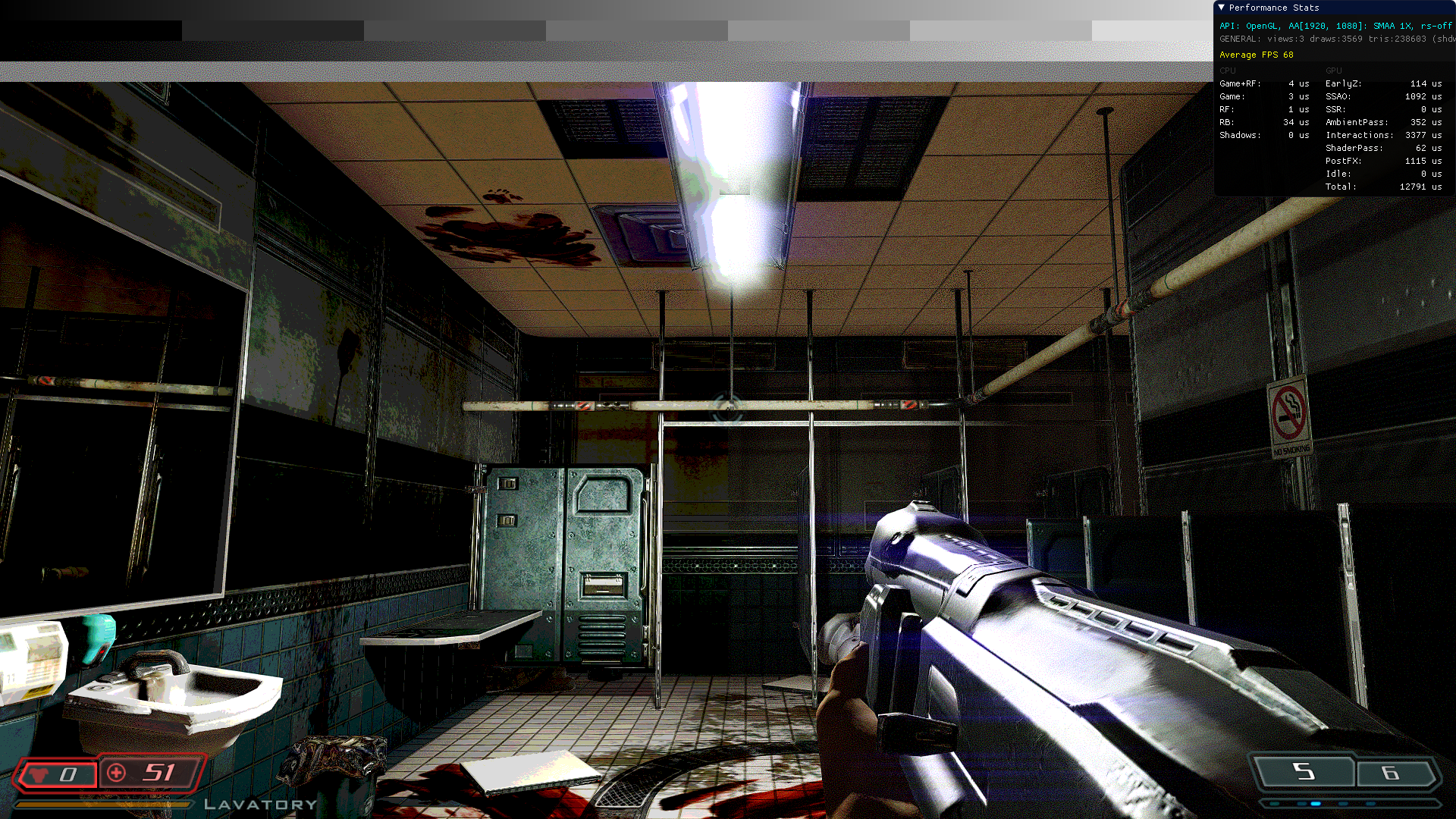
TrenchBroom Mapping Support
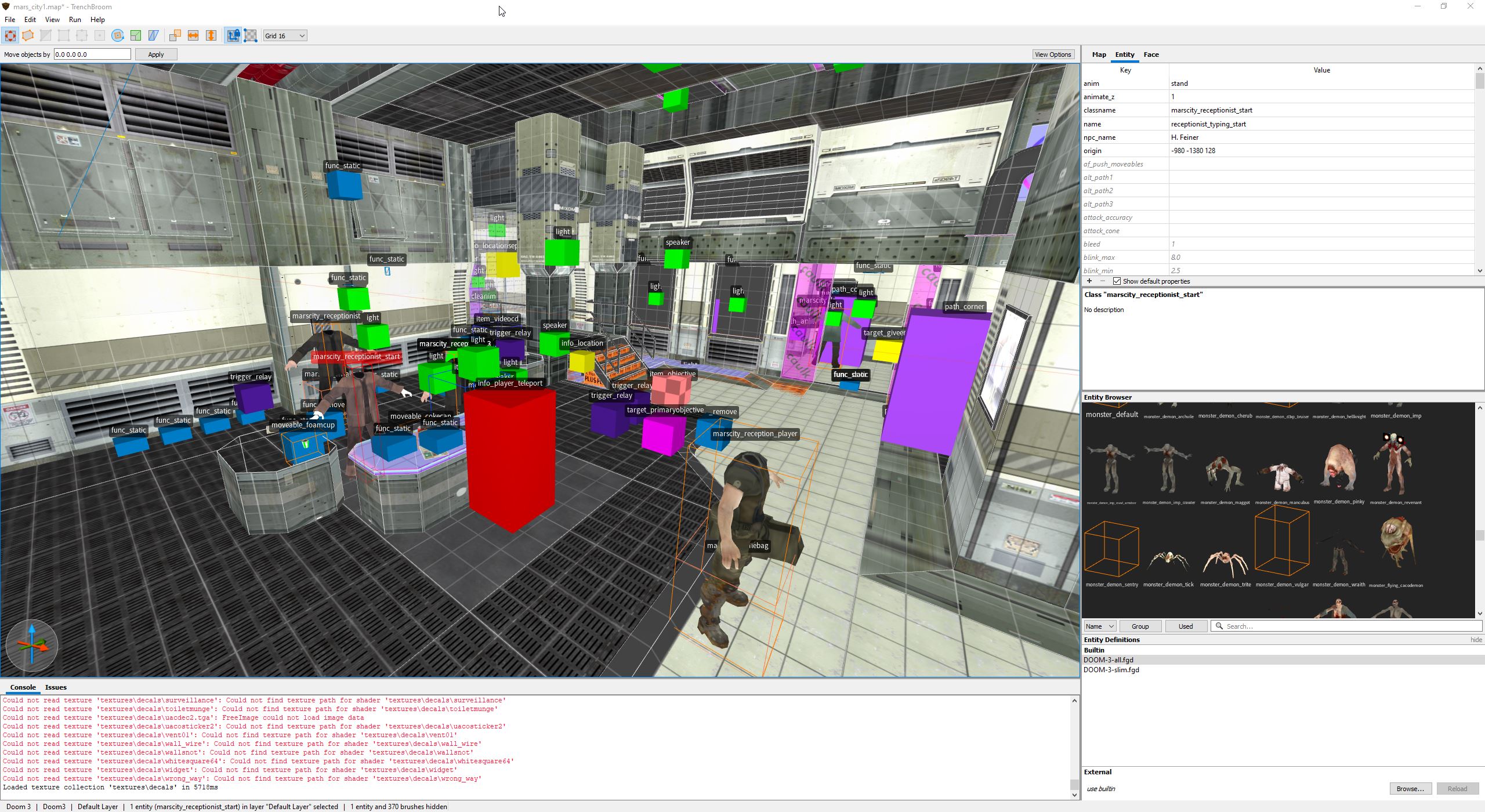
This is still very much Work in Progress and not supported by the official TrenchBroom.
Mapping for Doom 3 using TrenchBroom requires an extended unofficial build that is bundled with the official RBDOOM-3-BFG 7z package. You can find the customized version under tools/trenchbroom/.
Doom 3 also requires some extensions in order to work with TrenchBroom. I usually develop these things for RBDOOM-3-BFG but I created a seperated brach for vanilla Doom 3 so everybody can adopt TrenchBroom and the new Doom 3 (Valve) .map support.
The goal of the TrenchBroom support is to make it easier to create new maps. It doesn't allow to create bezier patches at the moment so you won't be able to edit existing Doom 3 maps.
You can only save maps to the Doom 3 Valve format but you can copy paste from the vanilla Doom 3 .map format into the Doom 3 (Valve)configuration and reset your texture alignment as you want. TrenchBroom doesn't support brush primitives like in D3Radiant or DarkRadiant and if you are familiar with TrenchBroom then you know that the preferred .map format is some kind of (Valve) .map format for your game.
The Quake 1/2/3 communities already adopted the Valve .map format in the BSP compilers and I did the same with dmap in RBDOOM-3-BFG.
Here is an overview of the changes made to TrenchBroom:
New
- Doom 3 .map parser with brushDef3, patchDef2, patchDef3 primitives
- Doom 3 Valve .map configuration
- Quake 3 .shader parser adopted to support .mtr
- .mtr support includes support for Doom 3 diffuse stages and the lookup for them is like in idMaterial::GetEditorImage()
- New Doom 3 OBJ parser. My TB Interop branch automatically creates OBJ files to work with TB and it also allows seamless interop with Blender 2.8x and 2.9x with the need of additional model formats for func_static entities (like misc_model for Quake 3)
- Game FGDs for Doom 3 and Doom 3 BFG
Issues
- It has no support for BFG .resource files and .bimage files. BFG only shipped for precompressed textures and no .tga files so people who want to mod for BFG have to copy the vanilla D3 base/textures/* and base/models/* to D3BFG/base/
- Many entities work differently in Doom 3 if they have an origin. Brush work in D3 is usually stored in entity space and not world space. This is a major issue. For new maps textures/common/origin has been reintroduced in the engine like in former times
- Doom 3's primary model formats are LWO and ASE. LWO and .md5mesh model support is missing.
- Some ASE models can't be loaded and materials are usually all wrong if loaded
- TrenchBroom doesn't support the "rotation" keyword and many models have the wrong orientation
- The custom TrenchBroom build breaks compatibility for other id Tech engines, e.g. entity links work between "target[num]" and "name" and not "targetname"
Some Scenes of Mars City 1 loaded into TrenchBroom
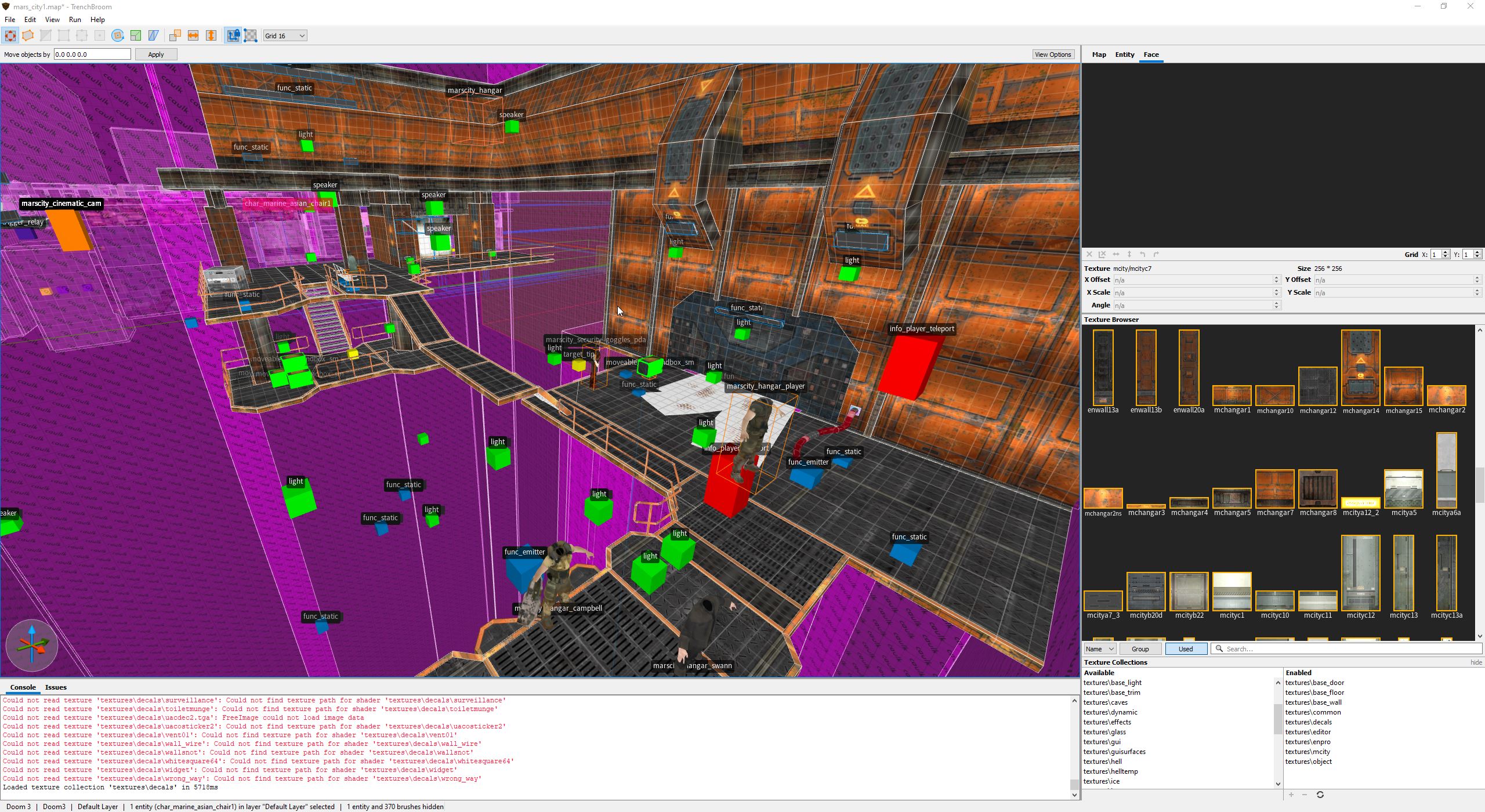

General Changelog
[PBR]
-
r_useHDR 1 is now the default mode and can't be turned off because it is a requirement for Physically Based Rendering
-
Changed light interaction shaders to use PBR GGX Cook-Torrance specular contribution. The material roughness is estimated by the old school Doom 3 glossmap if no PBR texture is provided
-
PBR texture support
-
Extended ambient pass to support Light Grids and Environment Probes
-
Turned off Half-Lambert lighting hack in favor of Image Based Lighting
-
Improved r_hdrDebug which shows F-stops like in Filament
-
Turned off r_hdrAutomaticExposure by default because it caused too much flickering and needs further work. The new default values work well with all Doom 3 content
-
r_lightScale (default 3) can be changed
-
Light shaders were tweaked with magic constants that r_forceAmbient 0.5, r_exposure 0.5 look as bright as in Doom 2016 or any other PBR renderer
-
SSAO only affects the ambient pass and not the direct lighting and the ambient occlusion affects the specular indirect contribution depending on the roughness of a material. See moving Frostbite to PBR (Lagarde2014)
-
Added HACK to look for PBR reflection maps with the suffix _rmao if a specular map was specified and ends with _s.tga. This allows to override the materials with PBR textures without touching the material .mtr files.
-
Fixed ambient lights, 3D GUIs and fog being too bright in HDR mode
-
Fixed darkening of the screen in HDR mode when you get hit by an enemy
-
Fixed ellipse bug when using Grabber gun in HDR mode #407
-
Added LoadEXR using TinyEXR, LoadHDR using stb_image
-
Optimized R_WriteEXR using TinyEXR compression
-
Added Spherical Harmonics math from Probulator by Yuri O'Donnell
-
Added Octahedron math by Morgan McGuire - Jcgt.org
[VULKAN]
-
NOTE THE VULKAN BACKEND IS STILL NOT FINISHED!!!
-
Fixed GPU Skinning with Vulkan
-
Fixed the lighting with stencil shadows with Vulkan and added Carmarck's Rerverse optimization
-
Added anisotropic filtering to Vulkan
-
Added Git submodule glslang 7.10.2984 -> stable release Nov 15, 2018
-
Vulkan version builds on Linux. Big thanks to Eric Womer for helping out with the SDL 2 part
-
Fixed Bink video playback with Vulkan
-
ImGui runs with Vulkan by skipping all Vulkan implementation details for it and rendering ImGui on a higher level like the Flash GUI
[TRENCHBROOM]
-
idMapFile and dmap were changed to support the Valve 220 .map format to aid mapping with TrenchBroom
-
Added exportFGD [models] console command which exports all def/*.def entityDef declarations to base/exported/_tb/ as Forge Game Data files. TrenchBroom has native support to read those files Developer.valvesoftware.com. Using the models argument will also export all needed models by entity declarations to base/_tb/ as Wavefront OBJ files.
-
To make it easier getting static models from Blender/Maya/3D Studio Max into TrenchBroom and the engine Wavefront OBJ model support has been ported from IcedTech
-
Support angles keyword again for TrenchBroom like in Quake 3
[MISCELLANEOUS]
-
com_showFPS bigger than 1 uses ImGui to show more detailed renderer stats like the original console prints with r_speeds
-
Removed 32bit support: FFmpeg and OpenAL libraries are only distributed as Win64 versions, 32bit CMakes files are gone
-
Added Blue Noise based Filmic Dithering by Timothy Lottes and Chromatic Aberration
-
Added Contrast Adaptive Sharpening (AMD) by Justin Marshall (IcedTech)
-
Improved Shadow Mapping quality with Vogel Disk Sampling by Panos Karabelas and using dithering the result with Blue Noise magic by Alan Wolfe
-
Improved Screen Space Ambient Occlusion performance by enhancing the quality with Blue Noise and skipping the expensive extra bilateral filtering pass
-
Updated idRenderLog to support RenderDoc and Nvidia's Nsight and only issue OpenGL or Vulkan debug commands if the debug extensions are detected. Reference: Devblogs.nvidia.com
-
Artistic Style C++ beautifier configuration has slightly changed to work closer to Clang Format's behaviour
-
Updated documentation regarding modding support in the README
-
Bumped the static vertex cache limit of 31 MB to roughly ~ 128 MB to help with some custom models and maps by the Doom 3 community
-
Added support for Mikkelsen tangent space standard for new assets (thanks to Stephen Pridham)
-
Renamed r_useFilmicPostProcessEffects to r_useFilmicPostProcessing
-
Replaced Motion Blur System Option with Filmic VFX (r_useFilmicPostProcessing)
-
Windows builds still require OpenGL 4.5 but they run in compatibility profile instead of core profile
-
Initial support for the MIPS64 architecture (thanks to Ramil Sattarov)
-
Initial support for the LoongArch64 architecture (thanks to Ramil Sattarov)
-
Initial support for the PPC64 architecture (thanks to Trung Lê)
-
Initial support for the Raspberry Pi 4 (thanks to Alejandro Piñeiro)
-
Updated Mac OS support (thanks to Steve Saunders)
-
Improved console layout (thanks to Justin Marshall)
-
Added invertGreen( normalmap.png ) material keyword to allow flipping the Y-Axis for tangent space normal maps
-
Changed to sys_lang to be saved to config so it has to be set per cmdline only a single time
-
Fixed bug that GOG builds default to Japanese instead of English
-
Support for Steam and GOG base path detection for Windows if sys_useSteamPath or sys_useGOGPath is set to 1 (default 0)
-
Changed CMake MSVC setup to enable debugging without manually changing paths (thanks to Patrick Raynor)
-
Allow _extra_ents.map files next to the original .map files so new entities can be added to existing maps or old entities can be tweaked with new values
-
Fixed DPI Scaling problems for 4K screens
[ASSETS]
-
This release is the first time that contains changes to the base/ folder and is not a pure executable patch
-
base/materials/*.mtr contain the Doom 3 BFG material files with some minor fixes so TrenchBroom can load them
-
base/def/*.def are the Doom 3 BFG entity definition files so DarkRadiant is functional
-
base/maps/game/mars_city1_extra_ents.map contains a fog light fix in the first hangar scene
-
base/maps/game/*_extra_ents.map files contain additional env_probe entities and light entity tweaks
-
base/maps/game/.lightgrid files and base/env/game//.exr contain the new precomputed PBR light data
-
New entity definition env_probe
-
New material textures/common/origin so mappers can create brushes that set the entity origin
-
Changed light entity definition to support Quake 1 light styles


This is amazing, downloading right now.
Thanks for this Robert!
Thanks for this! I hope that you'll continue improving TrenchBroom
Does anyone out here have a manual how to configure trenchbroom for D3 mapping??
There will be a 1.3.1 patch after Christmas with better TrenchBroom support and then I'm going to start a YouTube series on how to use TrenchBroom for RBDOOM-3-BFG.
simply and pure art....dude you are awesome
I think I missed something - how do we install this mod?
This comment is currently awaiting admin approval, join now to view.
Hi, how do I turn on the global illumination feature?